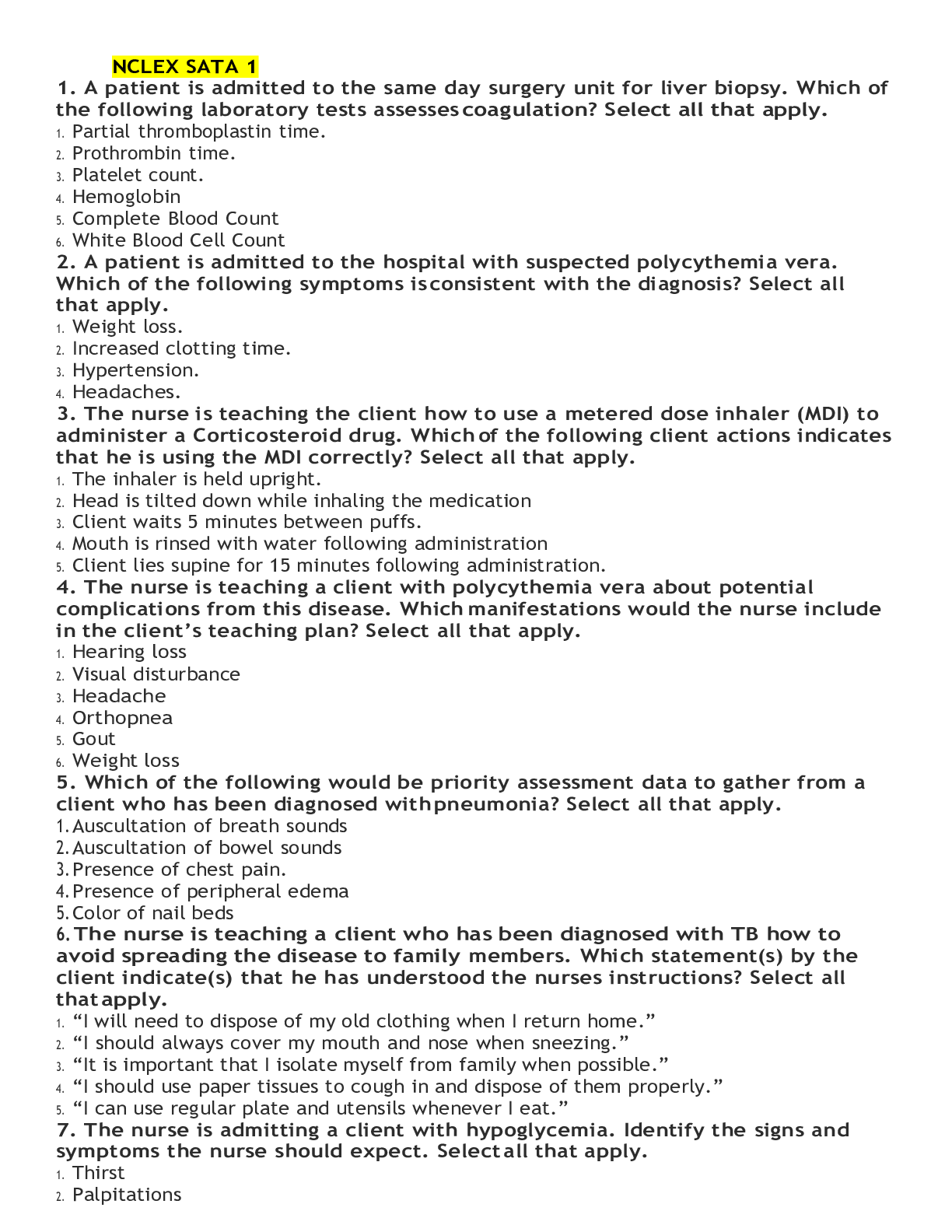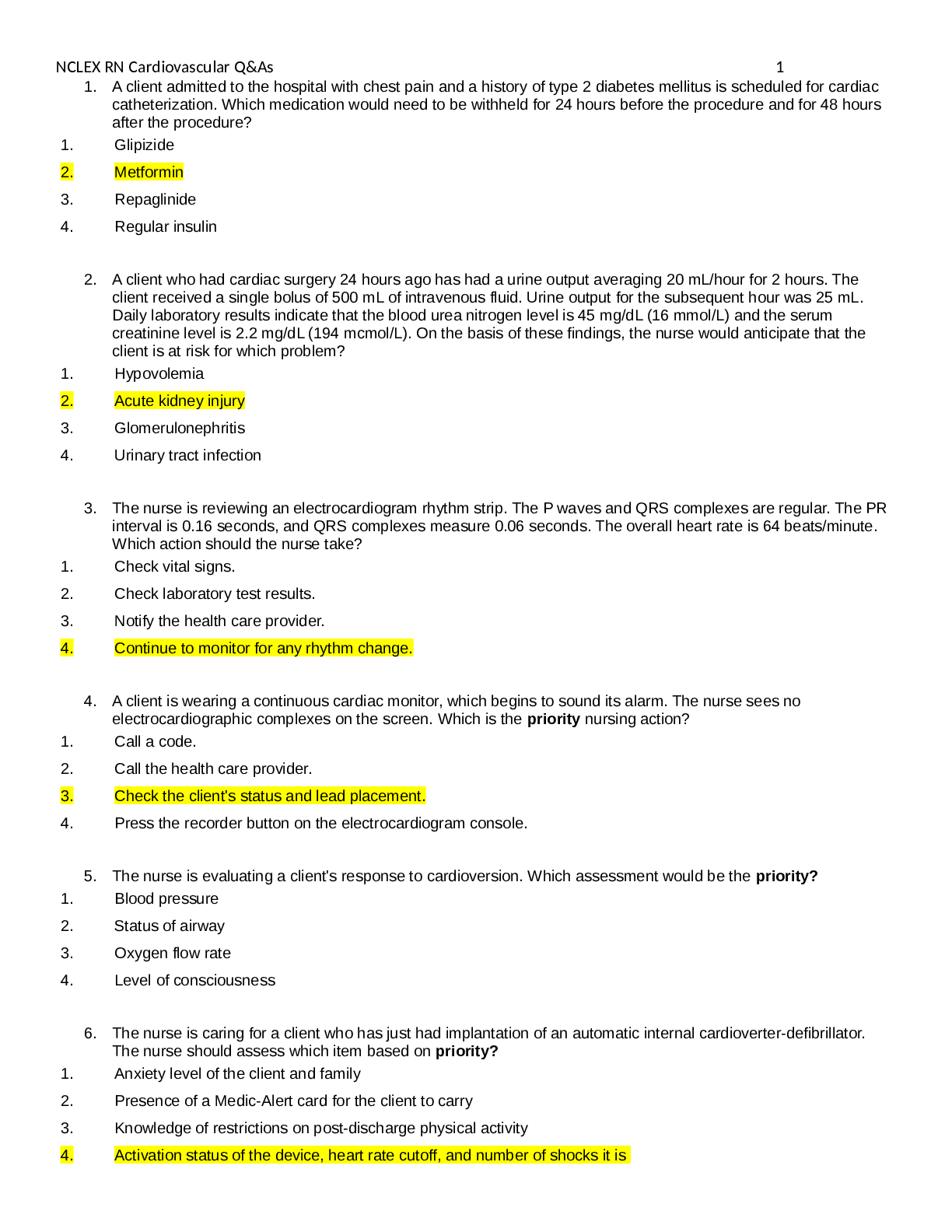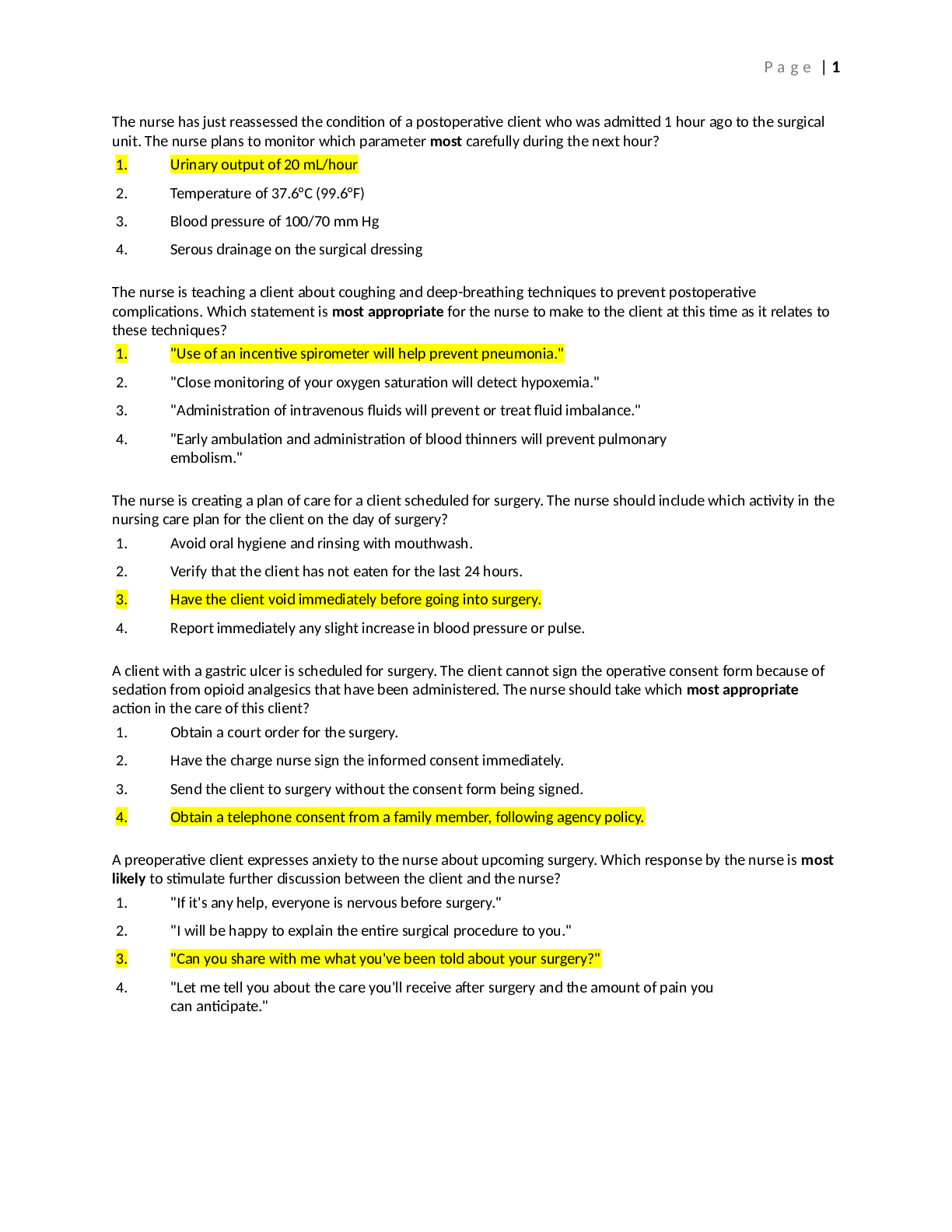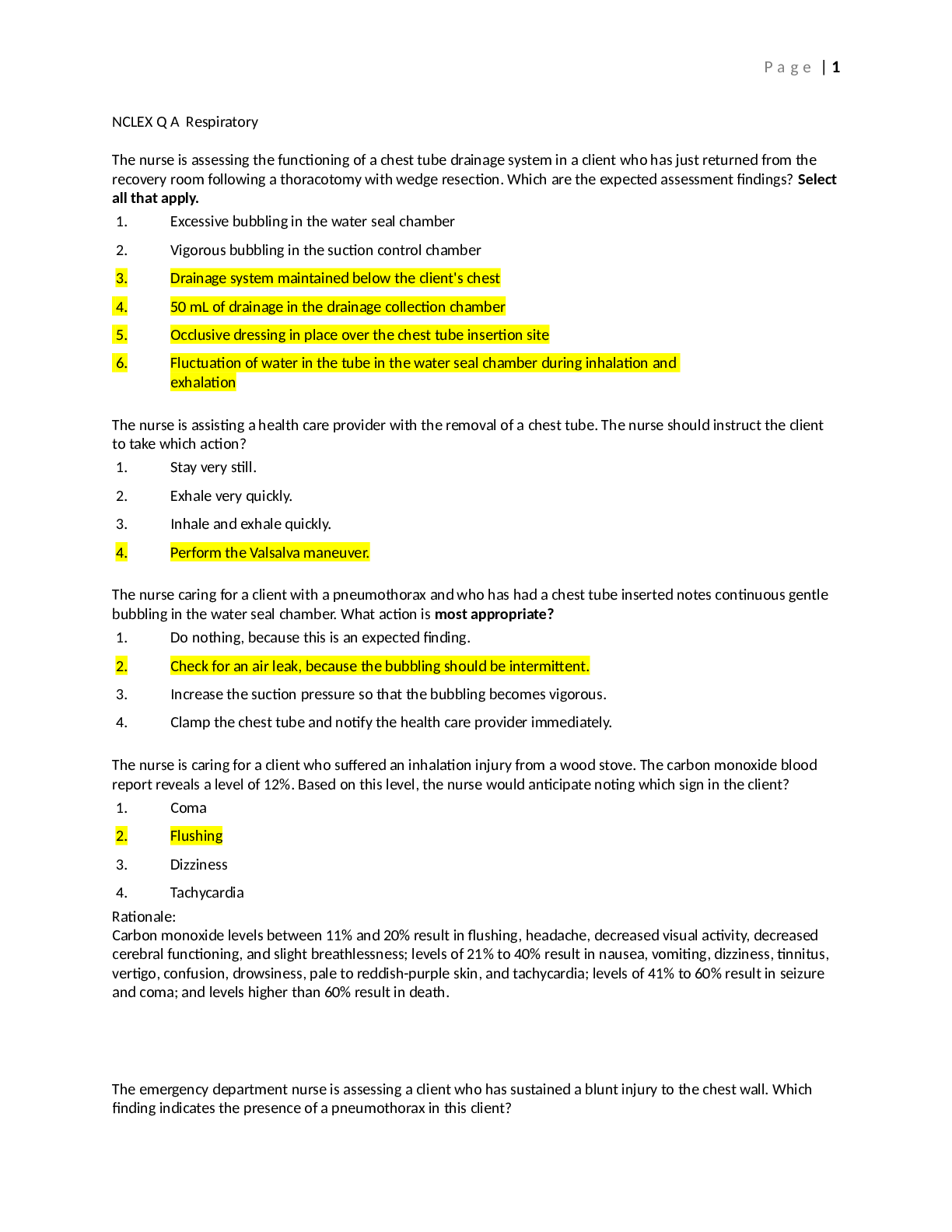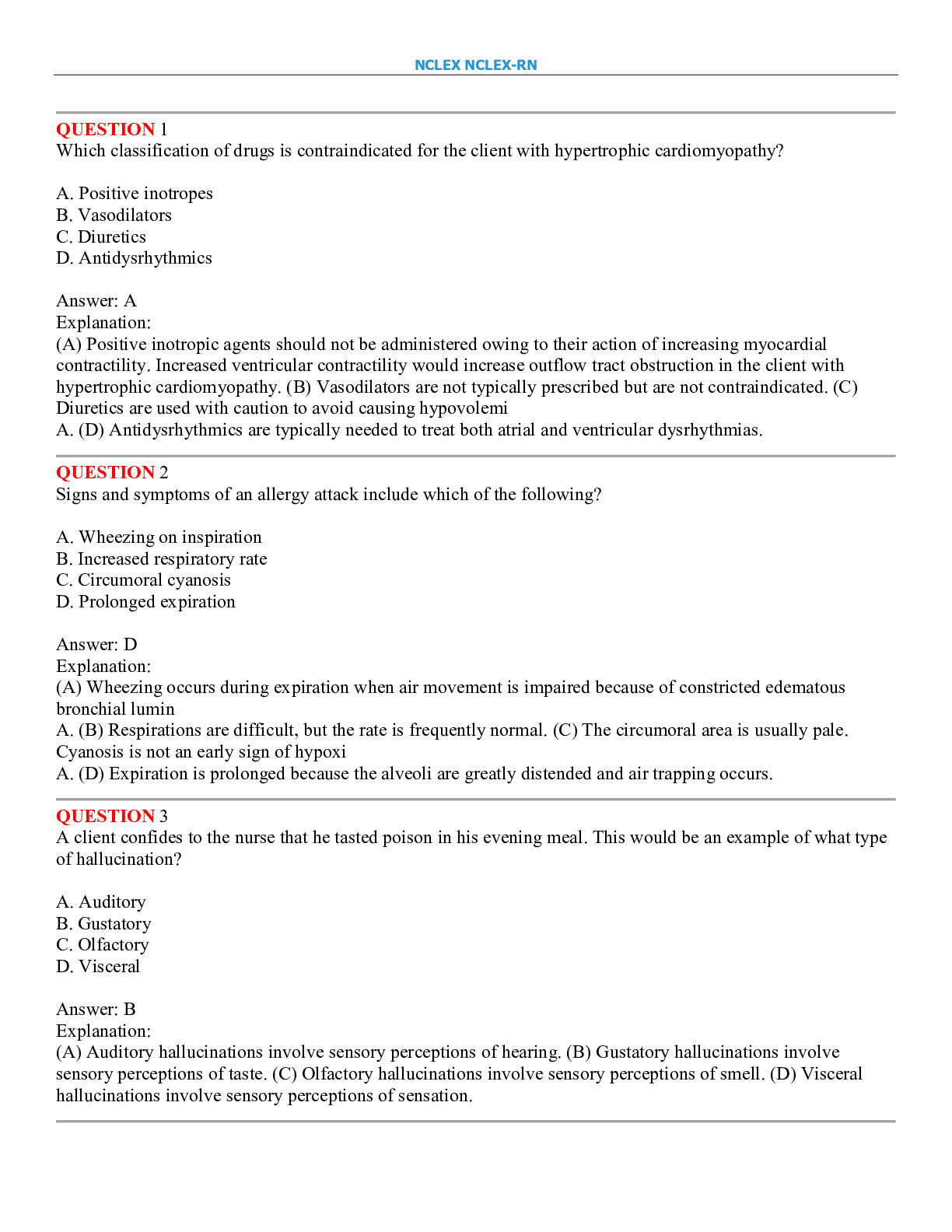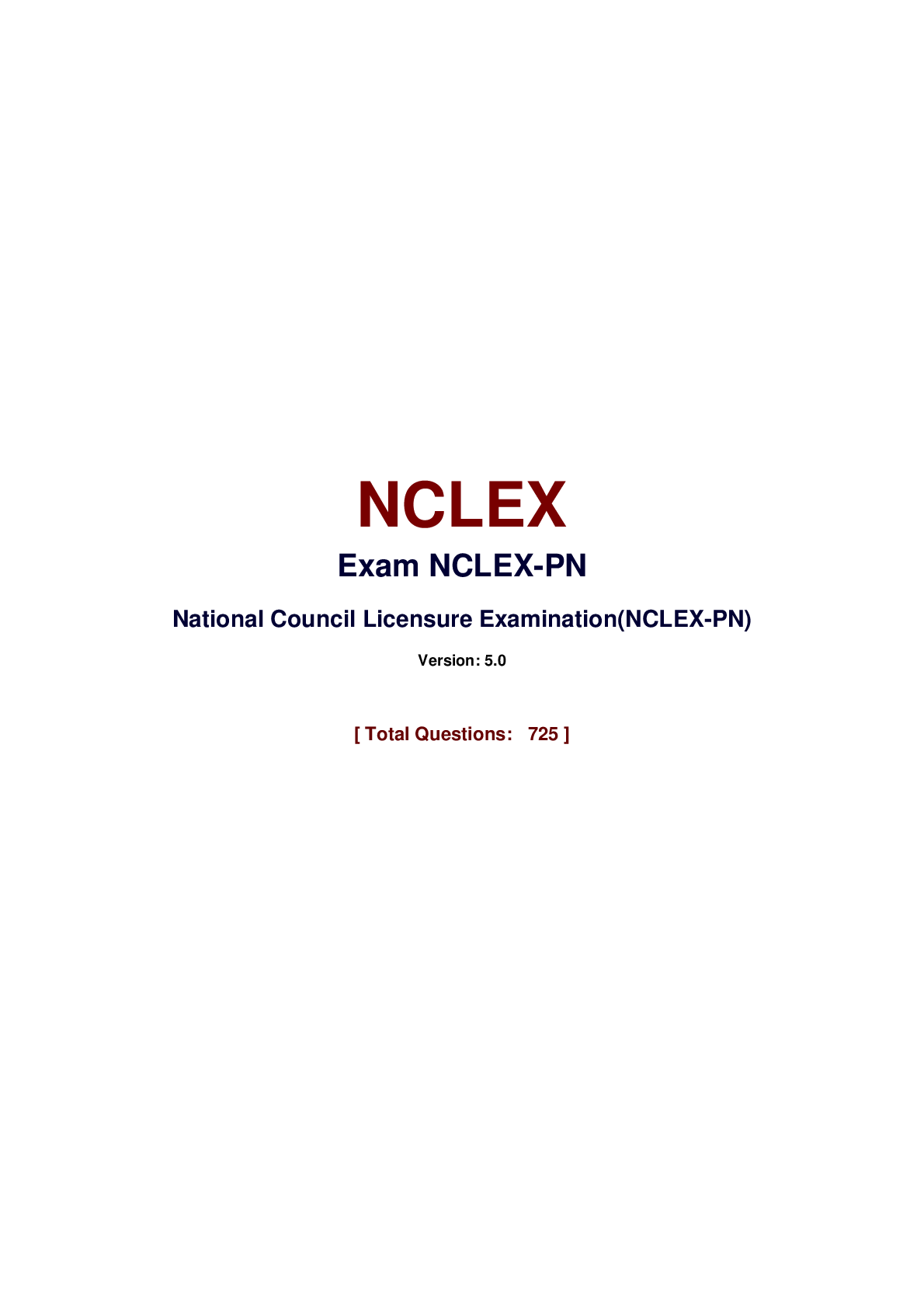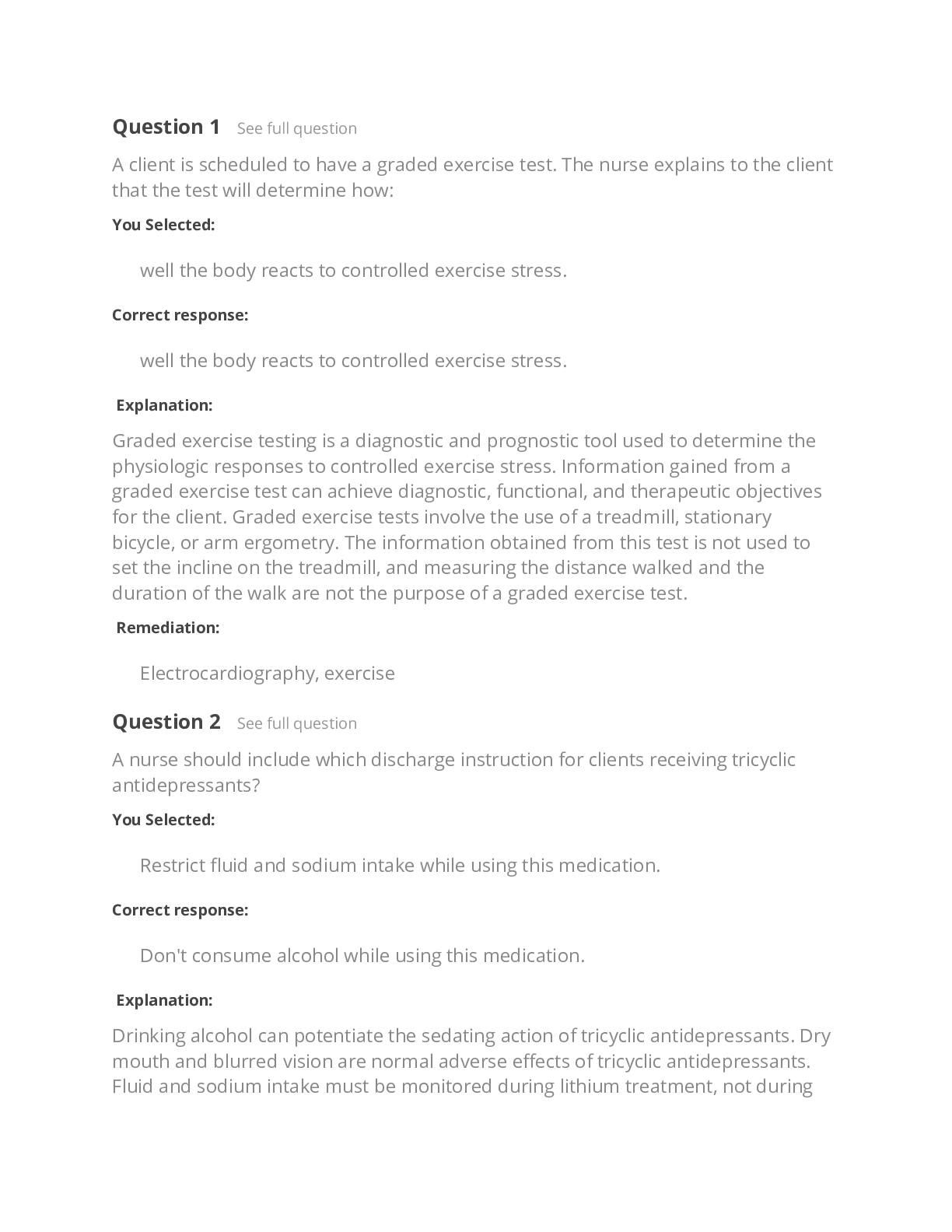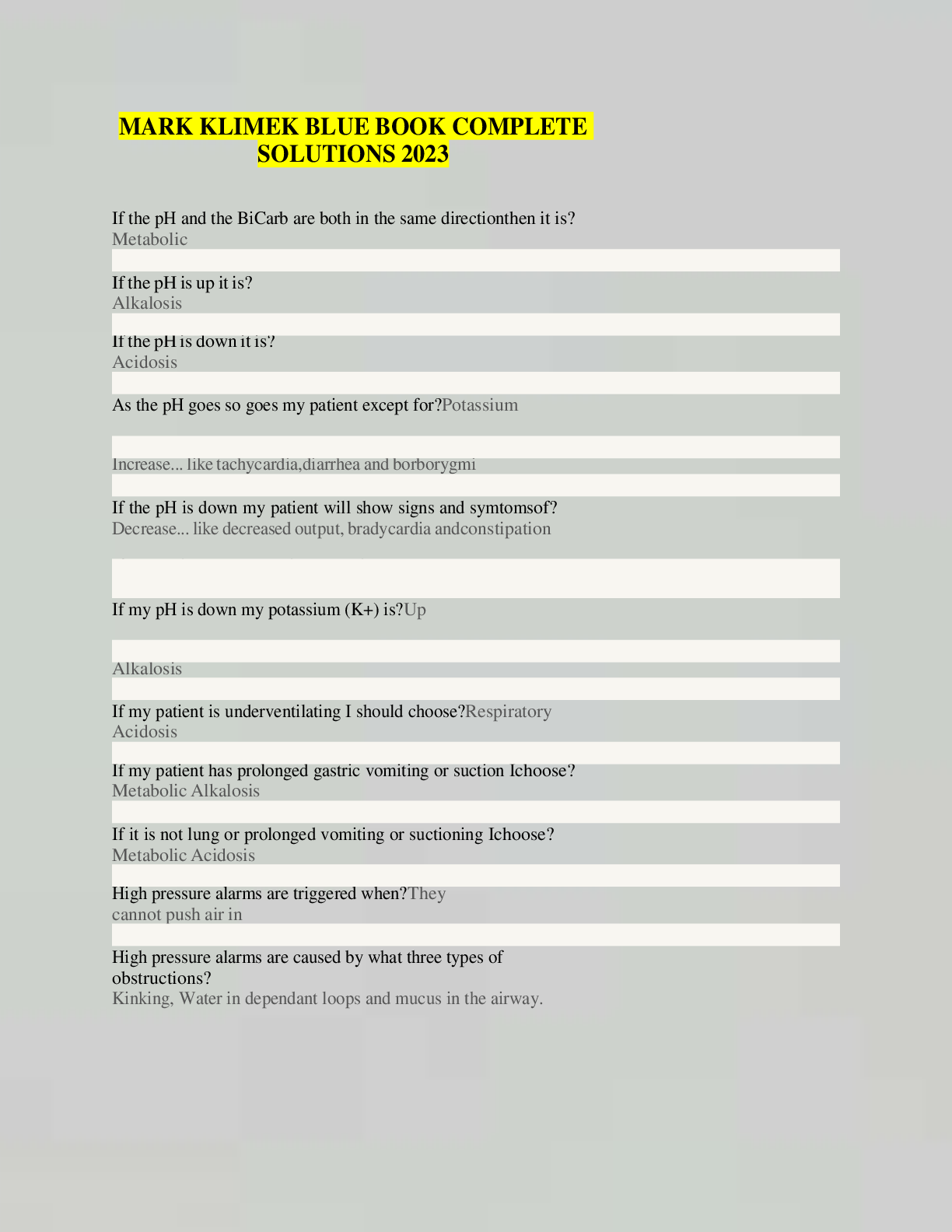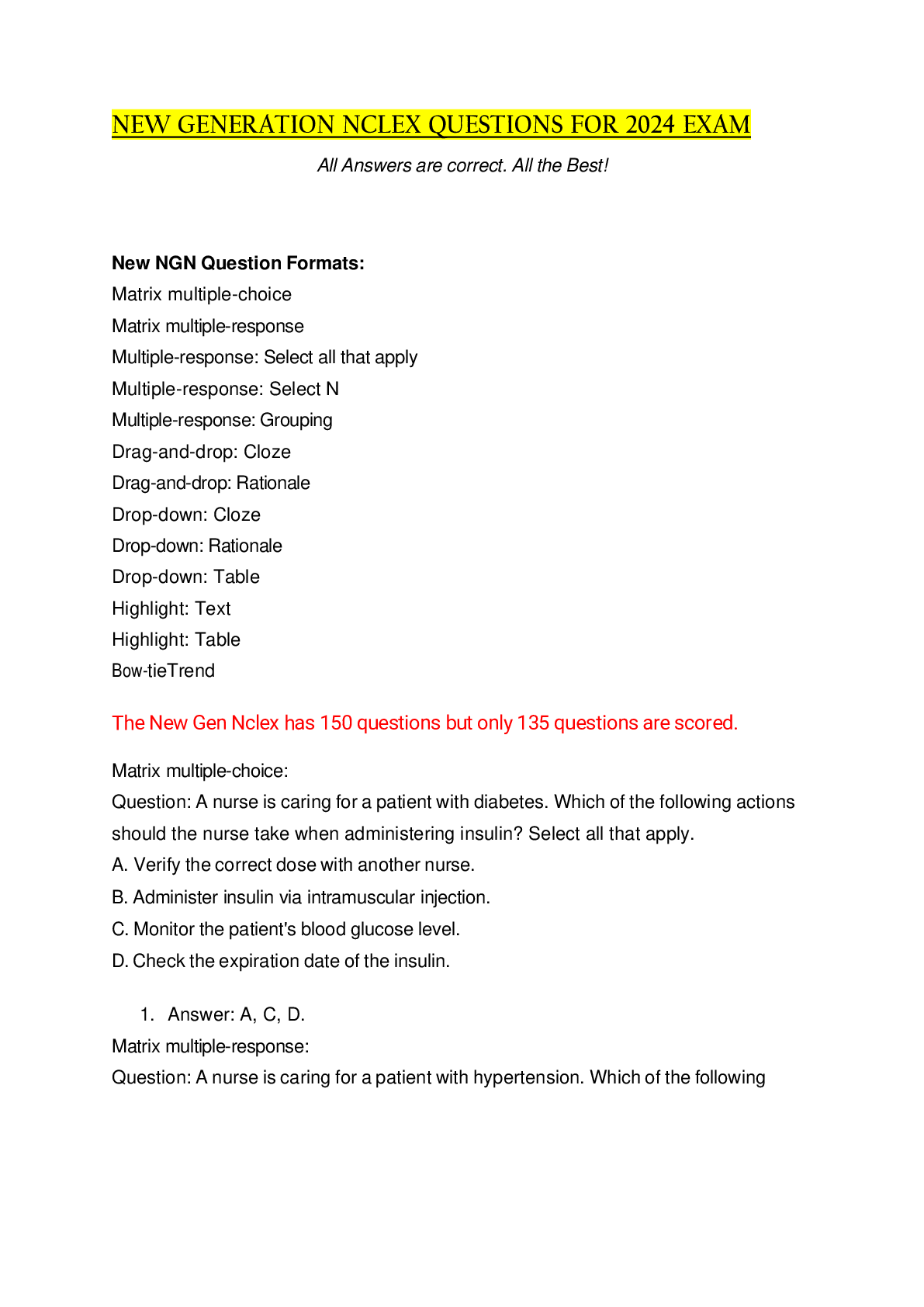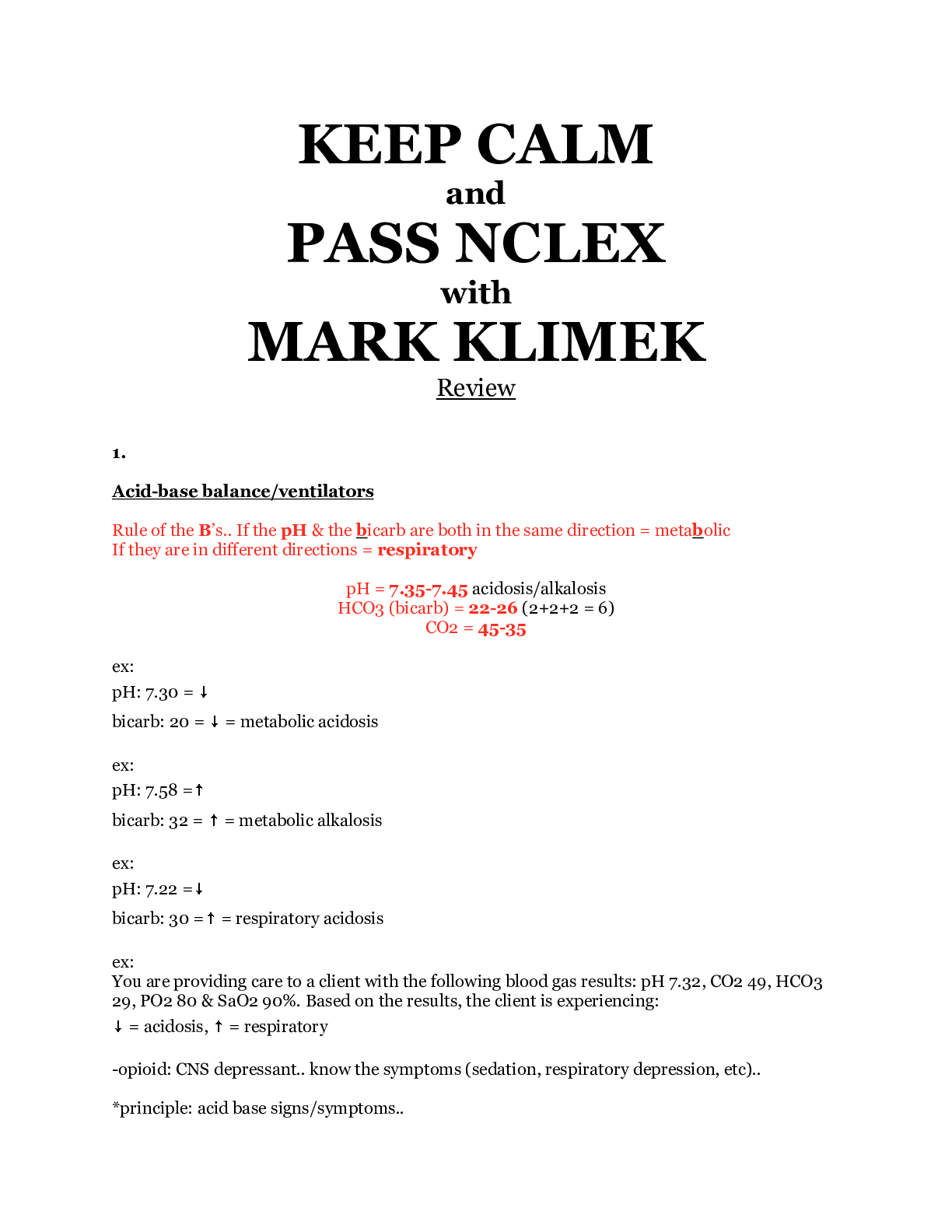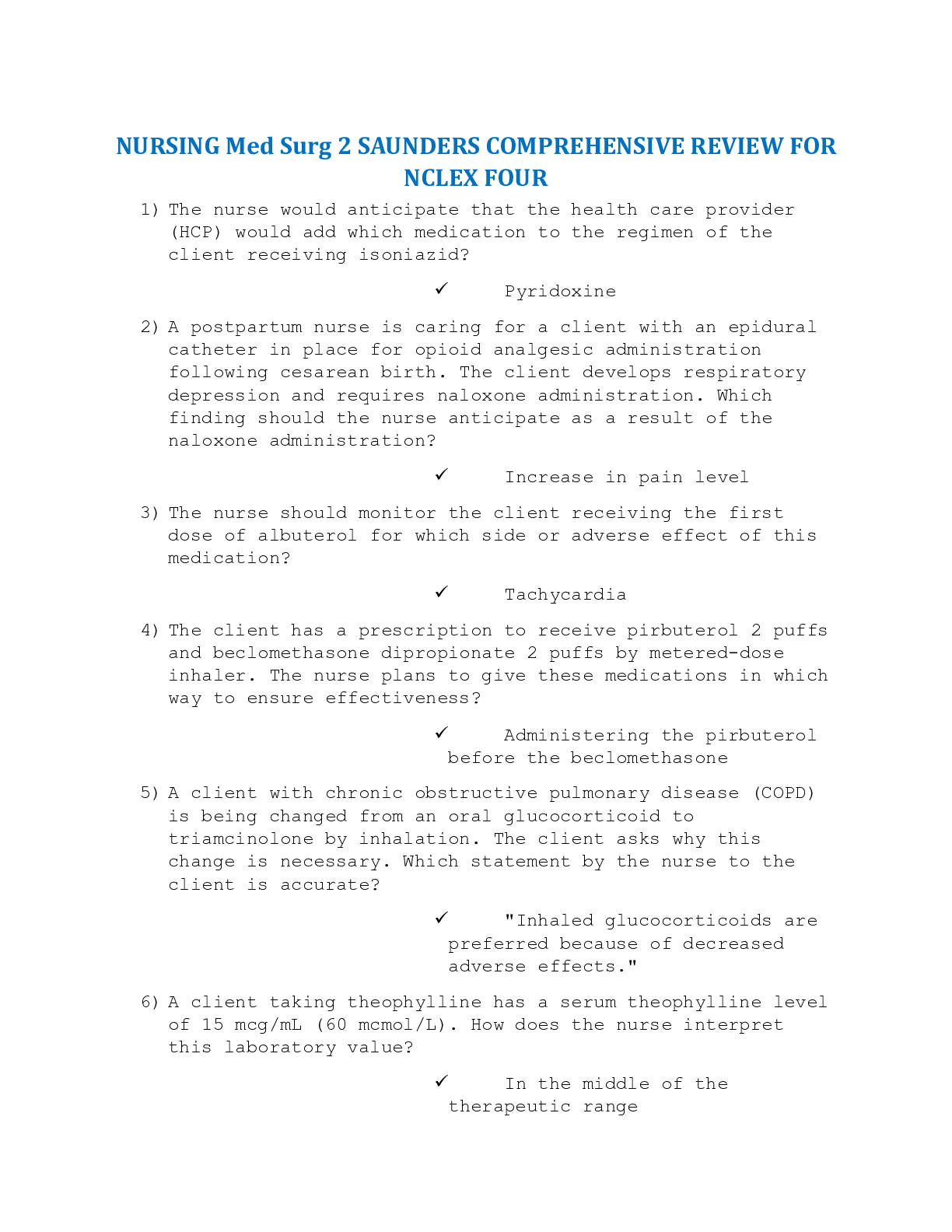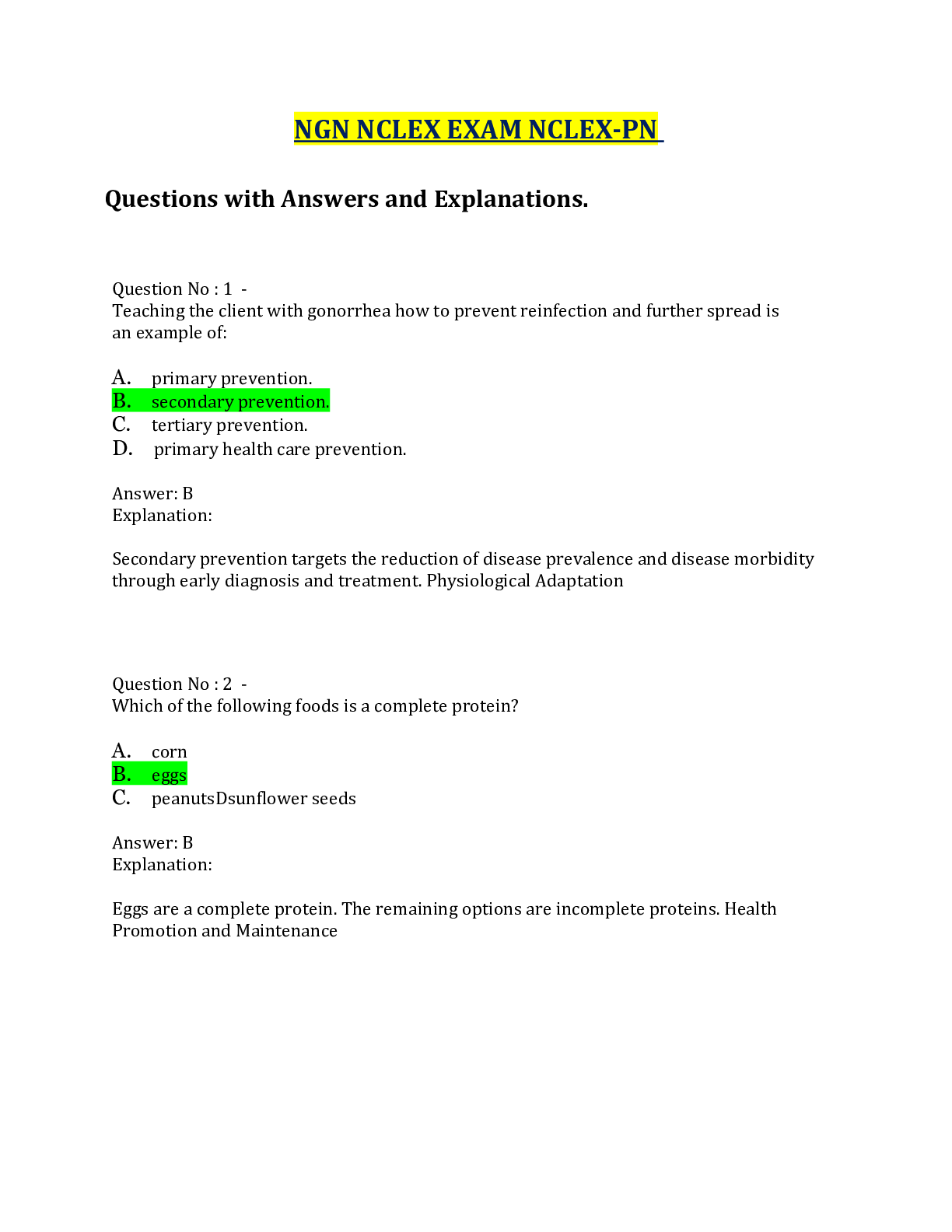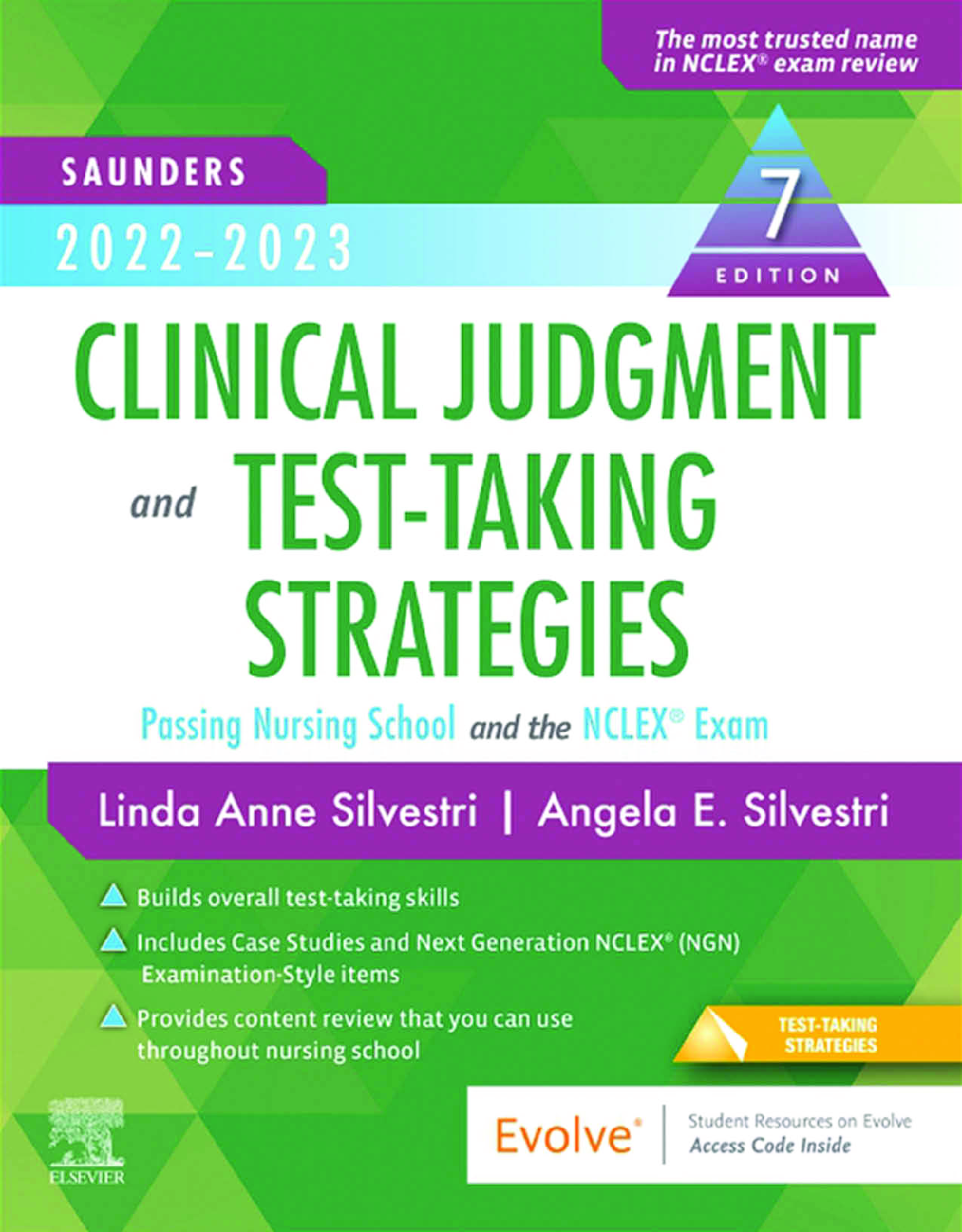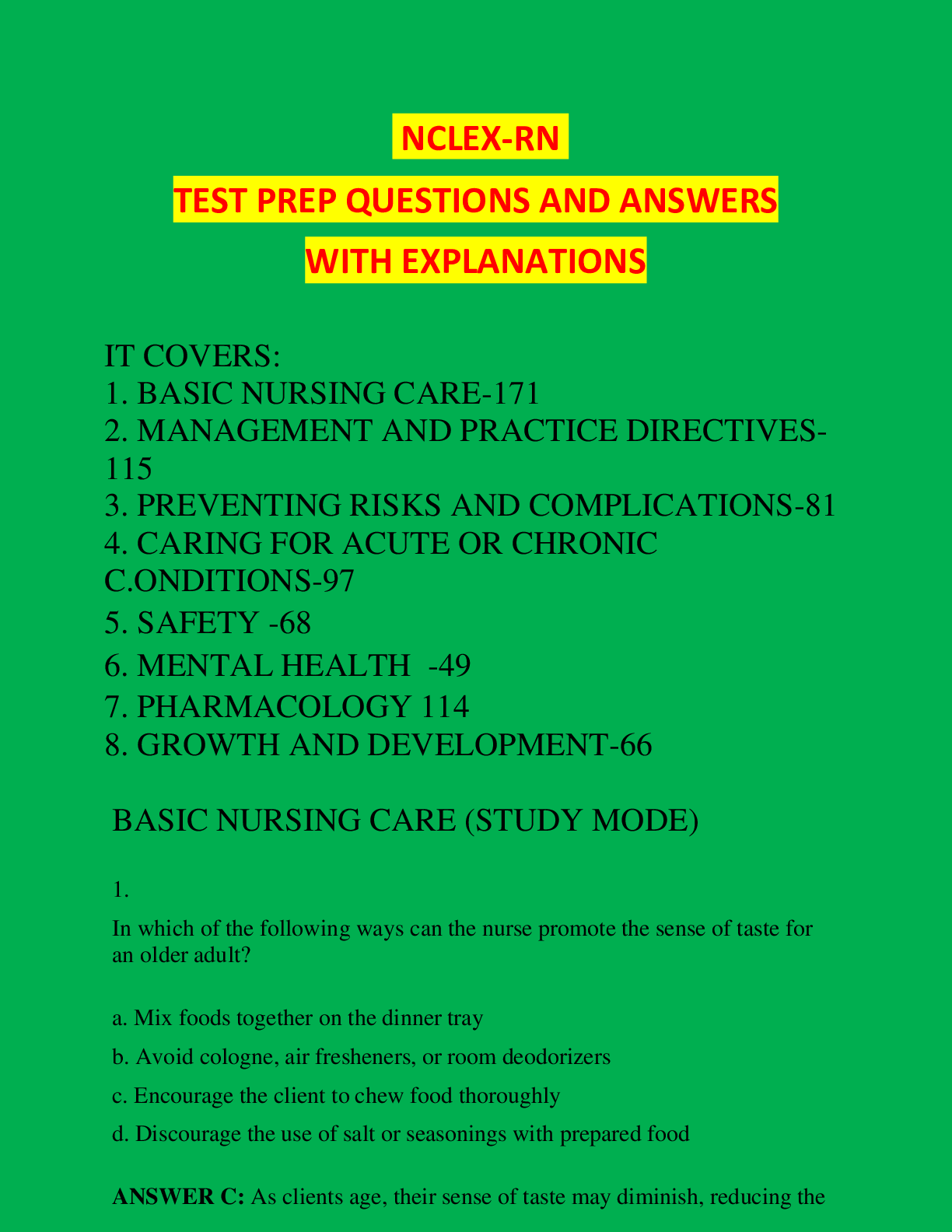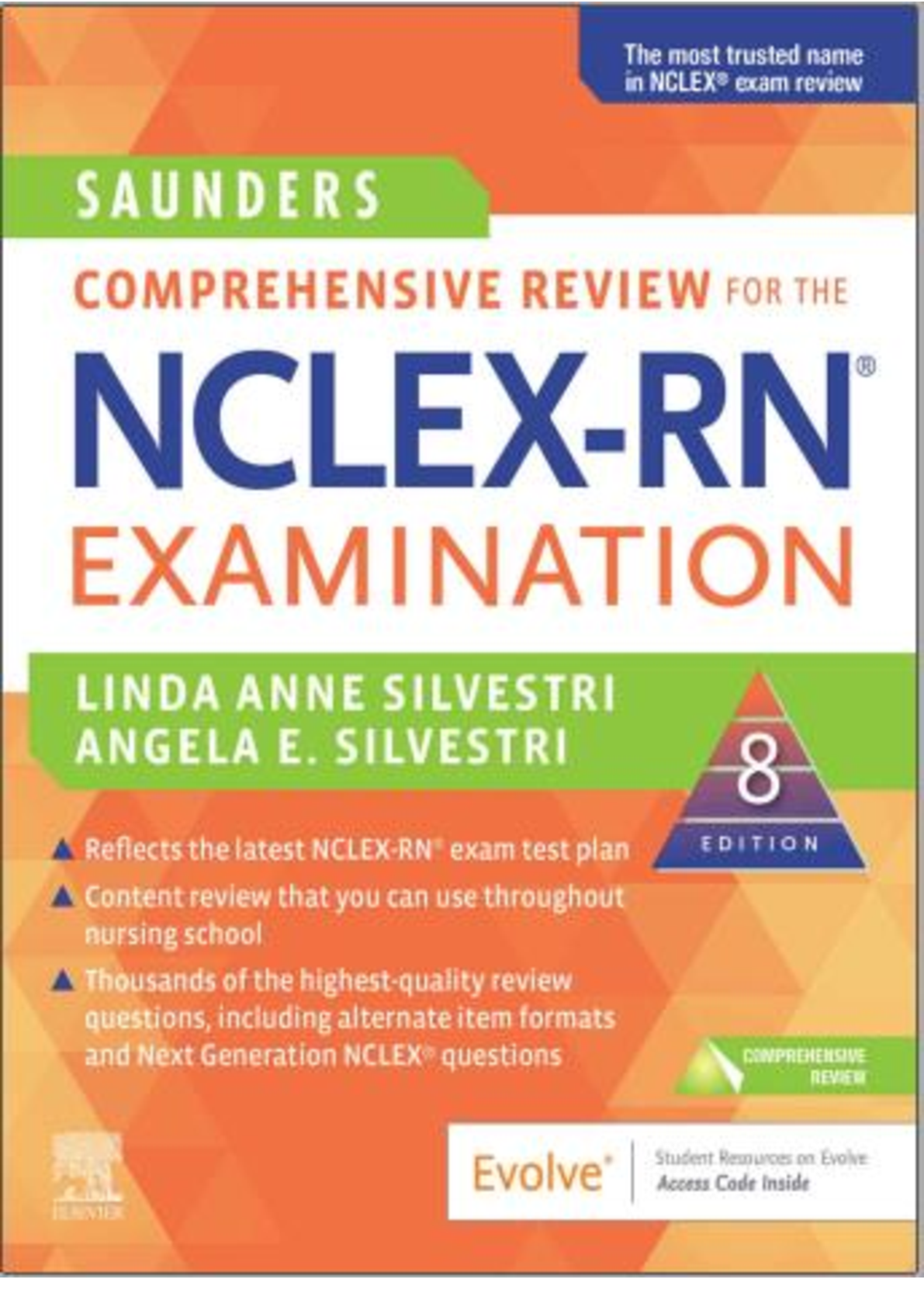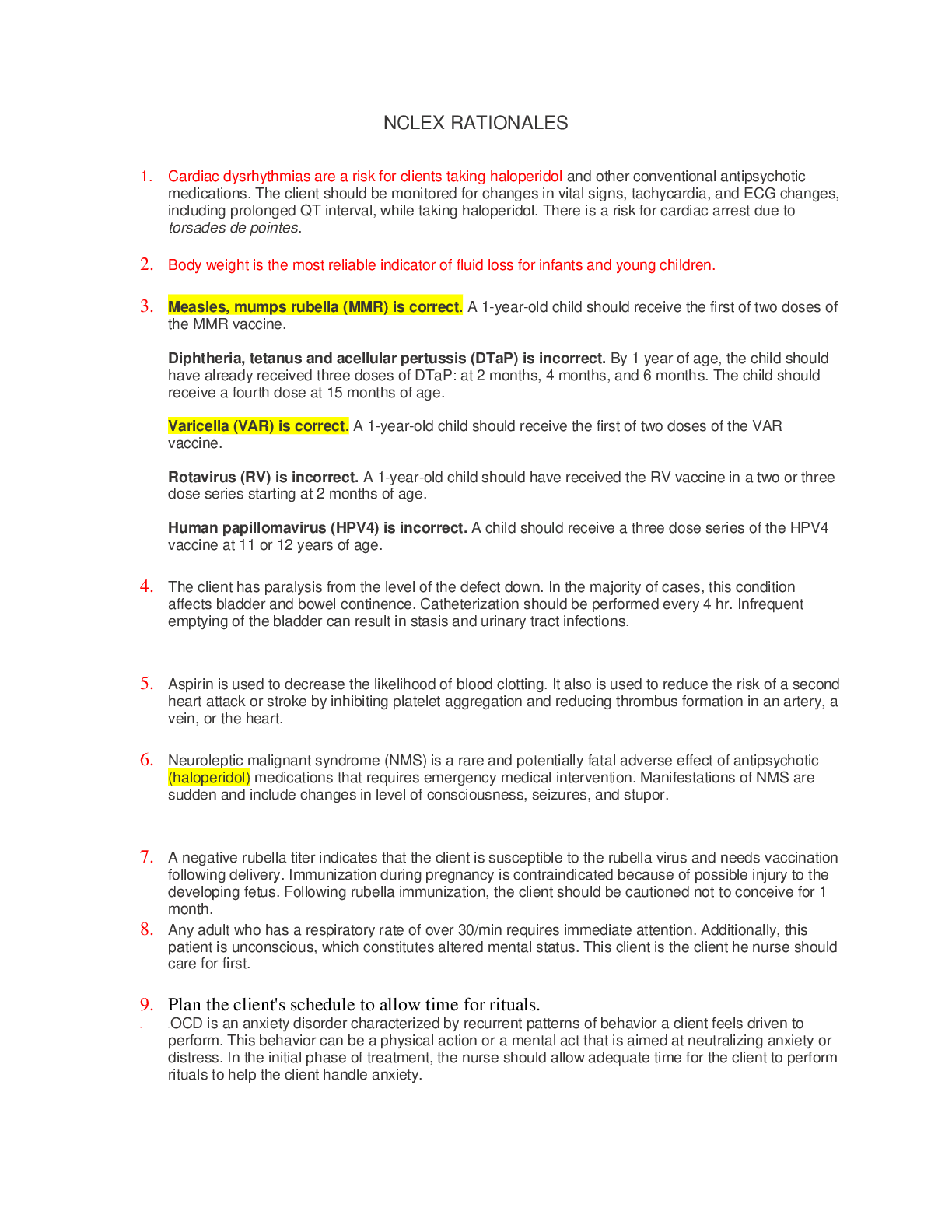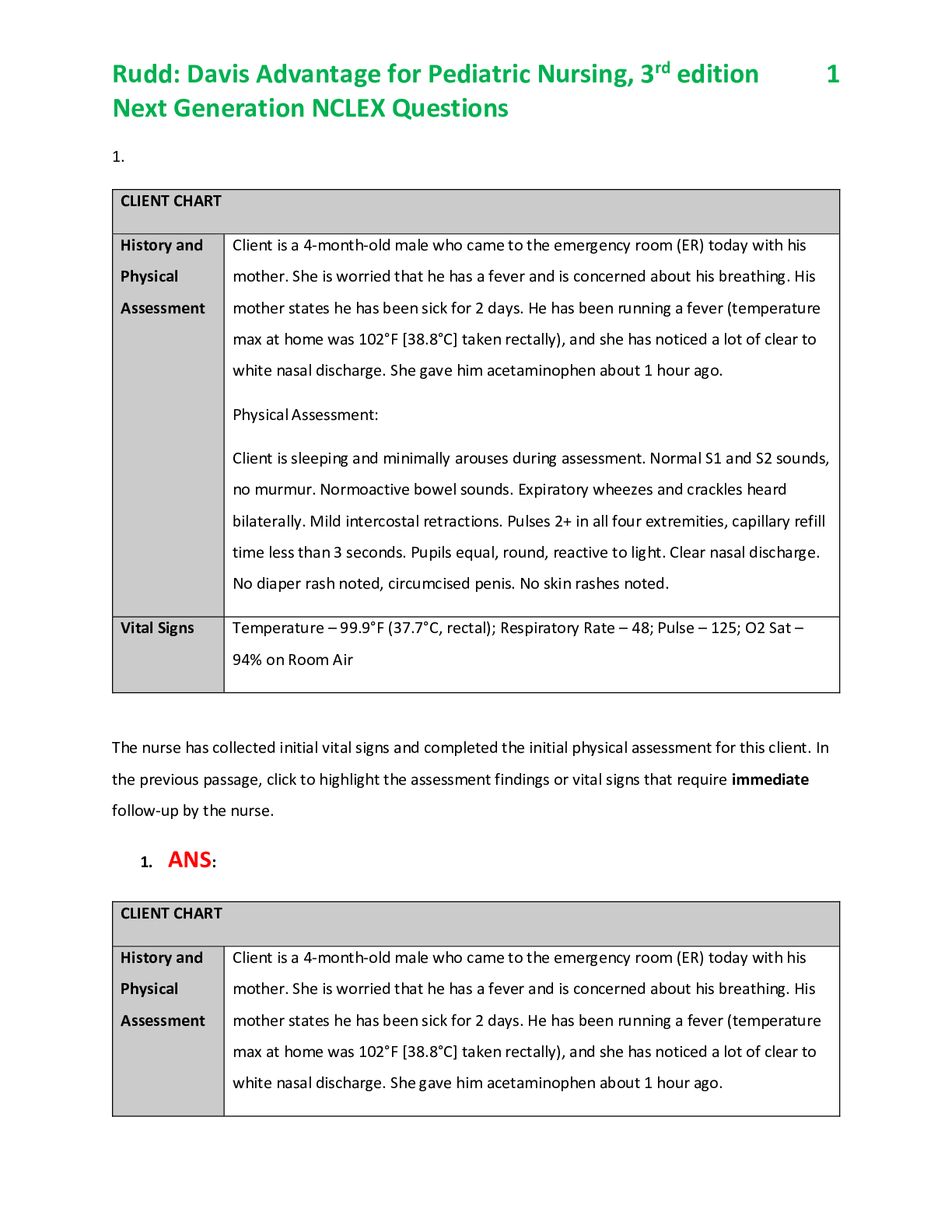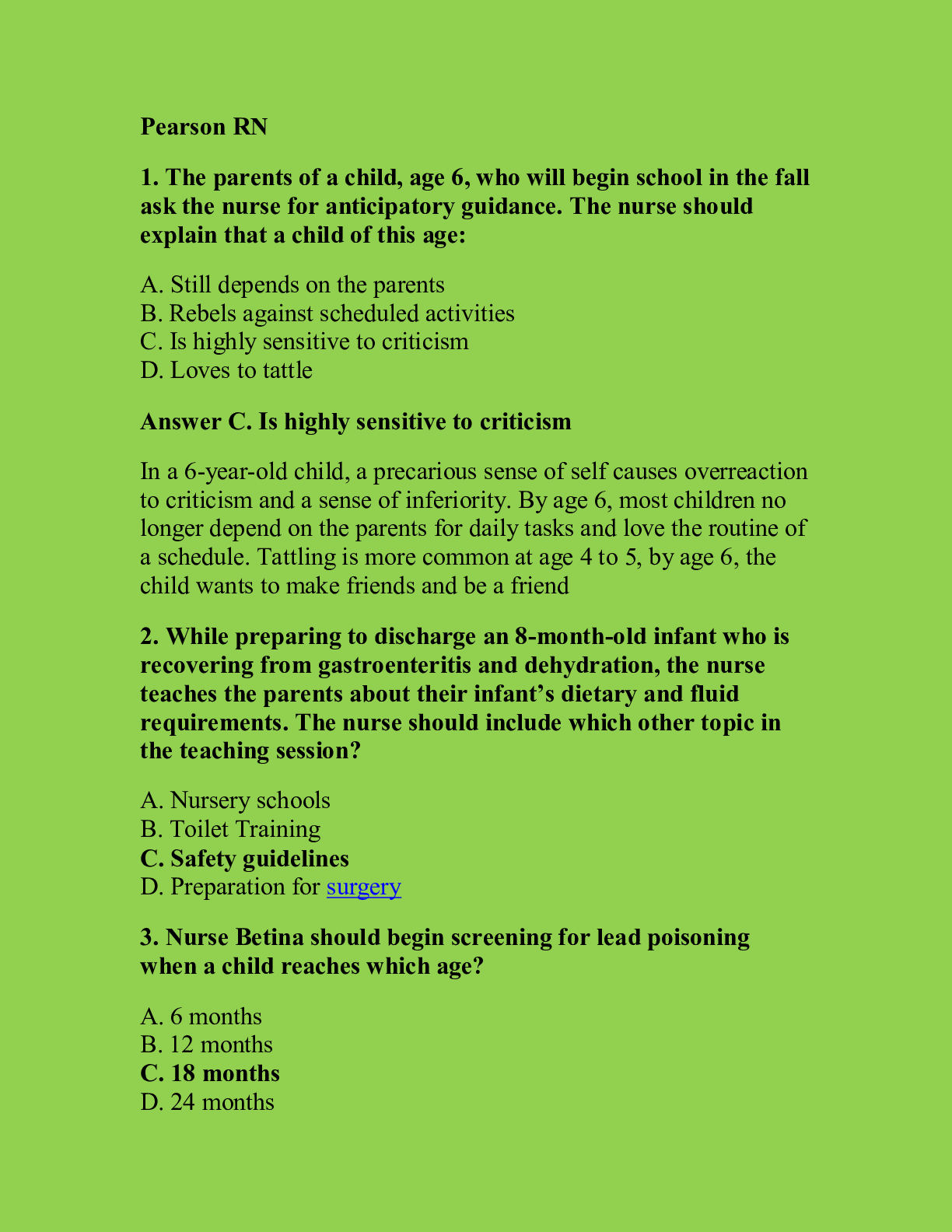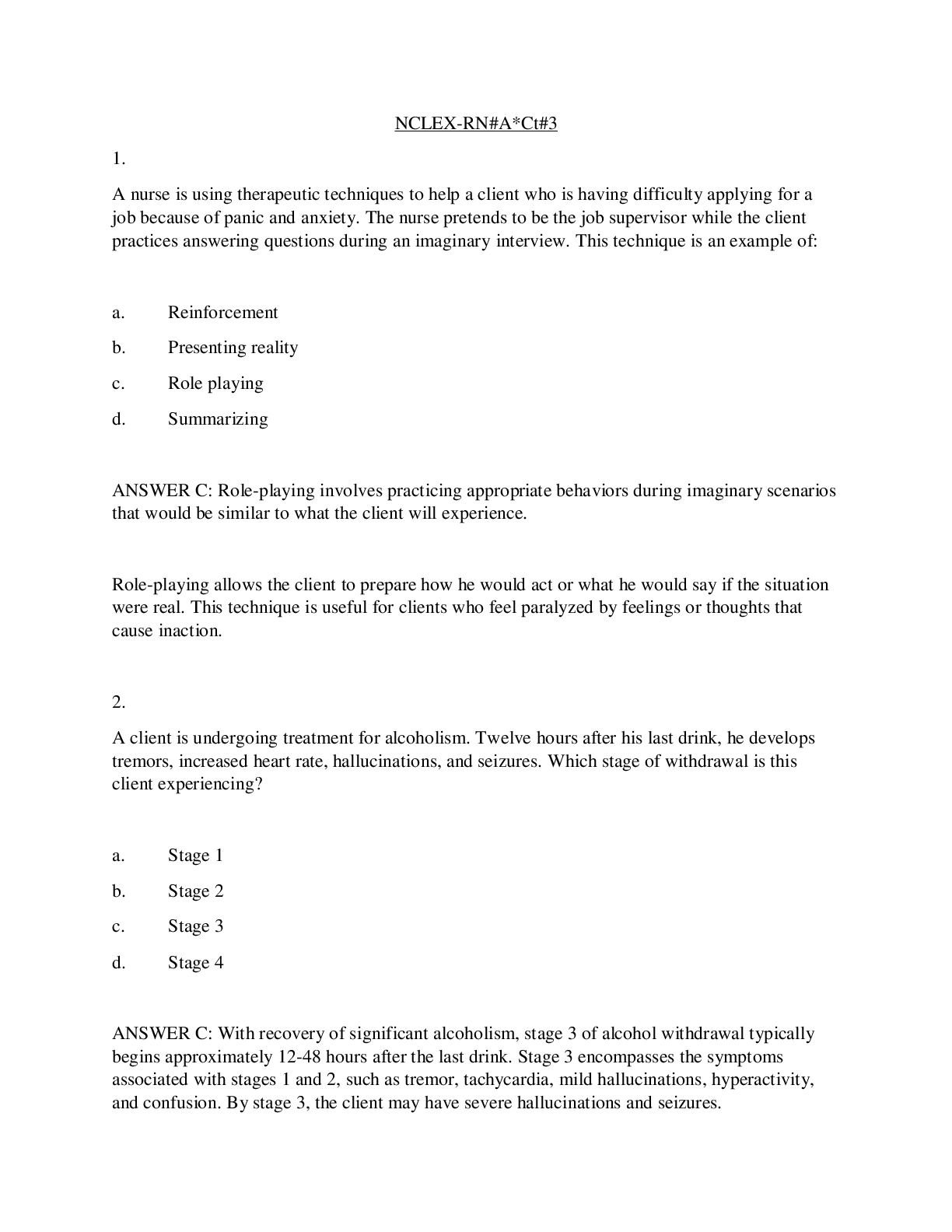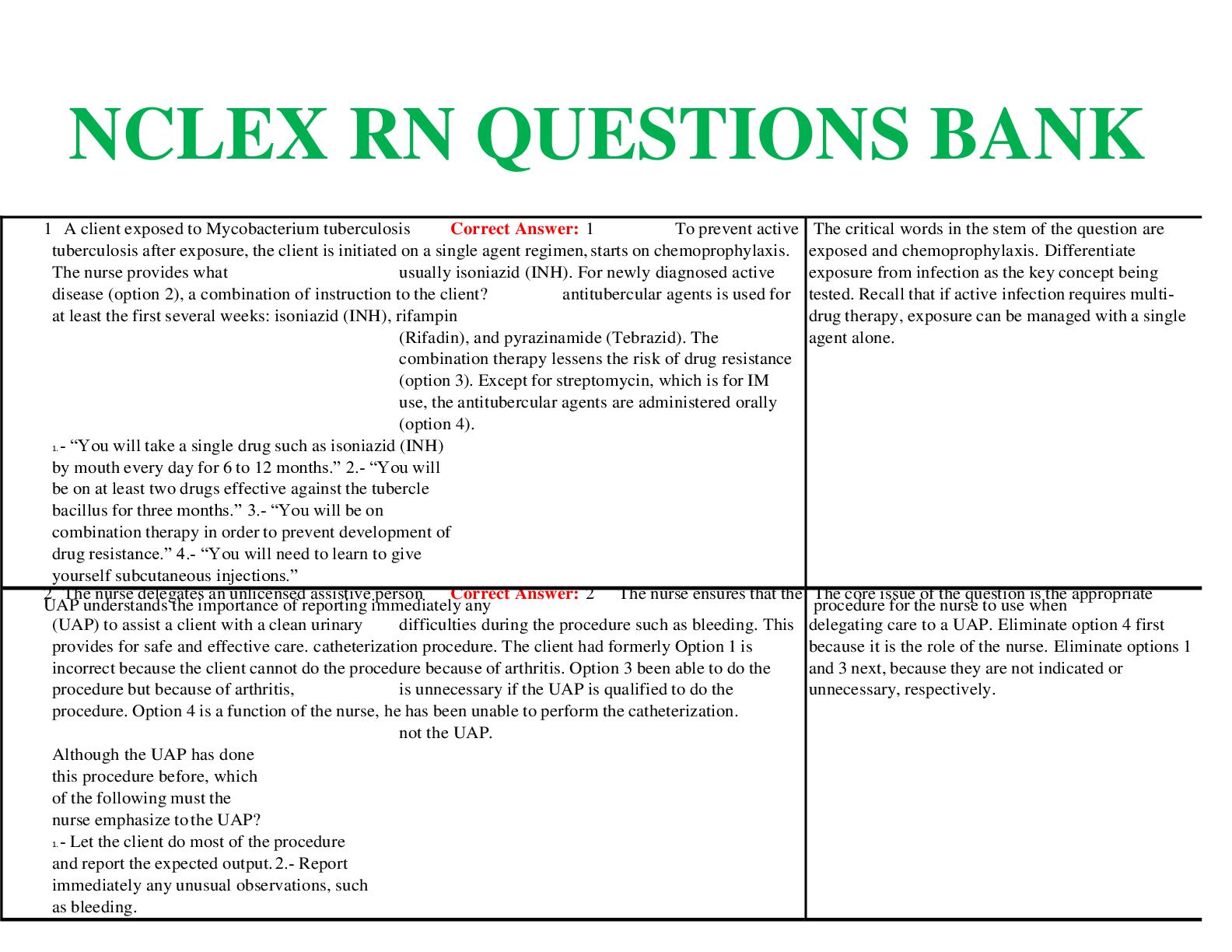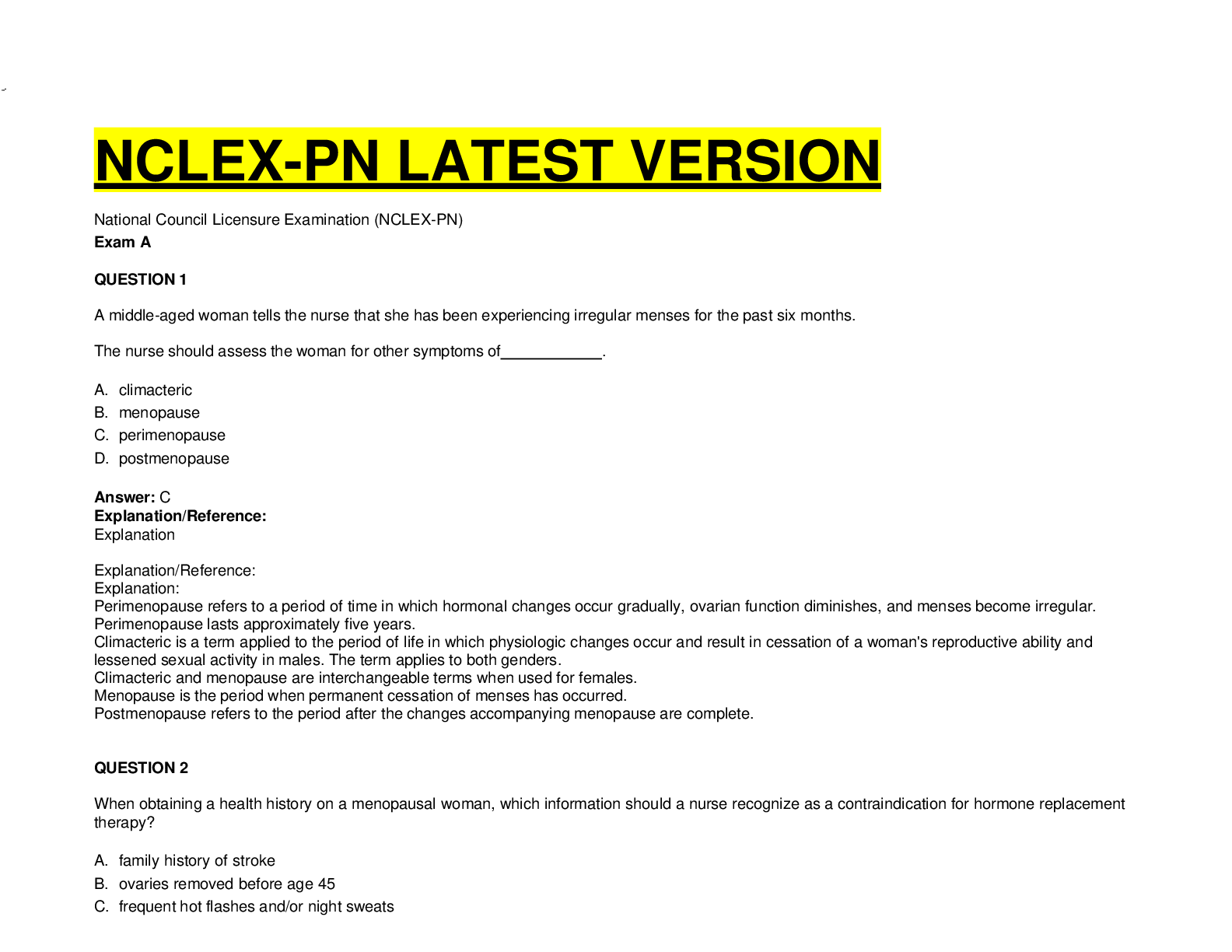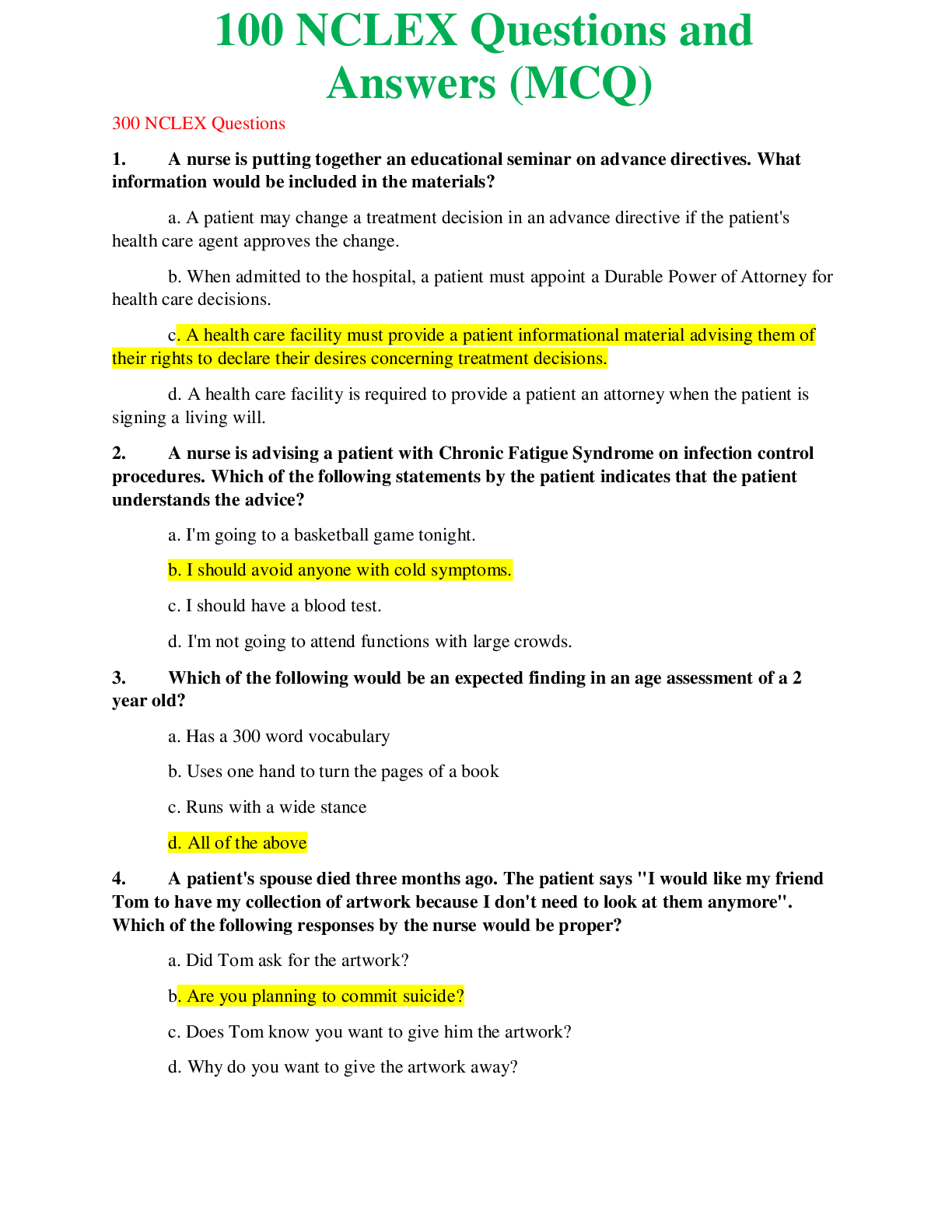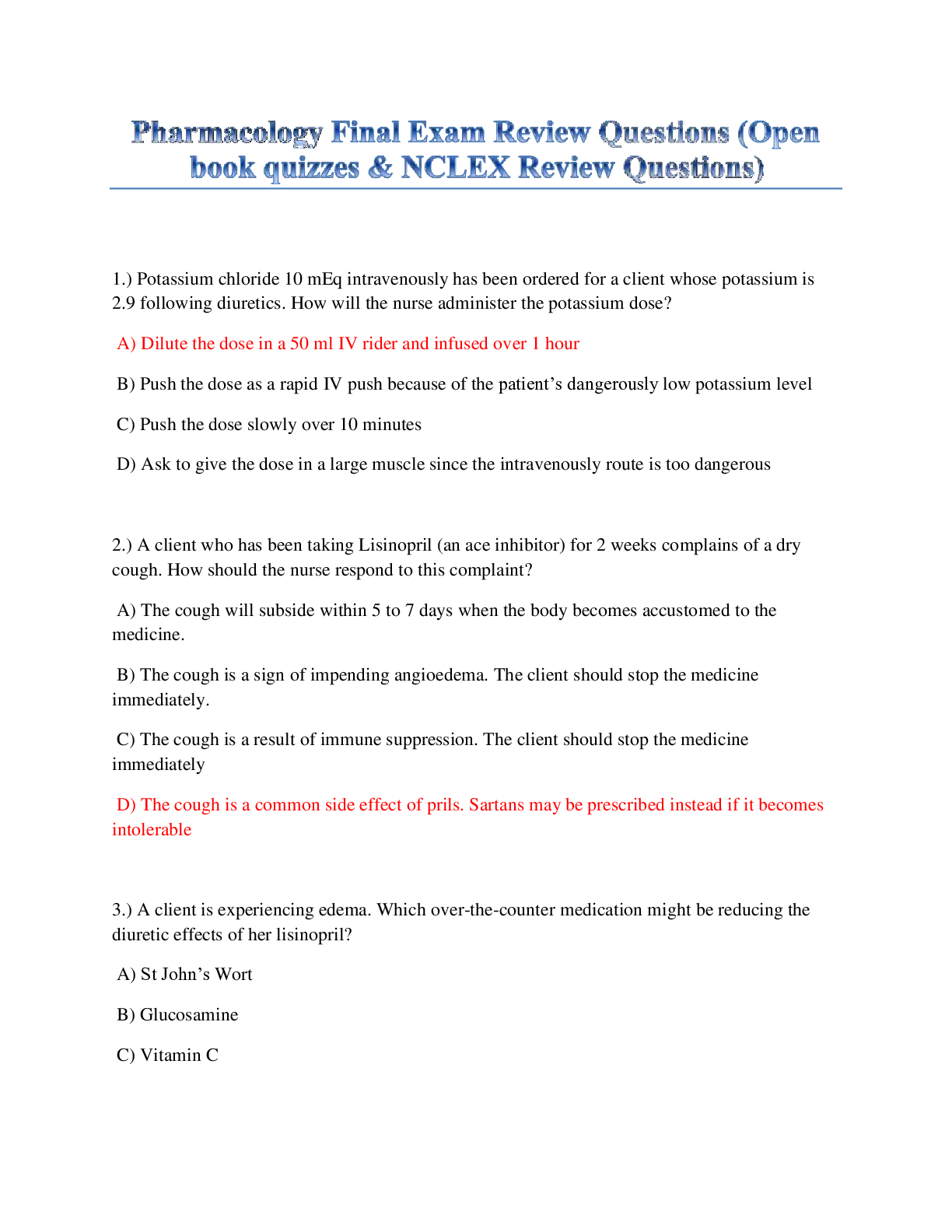Respiratory System NCLEX Questions
Document Content and Description Below
Respiratory System NCLEX Questions The most important action the nurse should do before and after suctioning a client is: a. Placing the client in a supine position b. Making sure that suctioning ta... kes only 10-15 seconds c. Evaluating for clear breath sounds d. Hyperventilating the client with 100% oxygen Correct answer- d. Hyperventilating the client with 100% oxygen 2. The position of a conscious client during suctioning is: a. Fowler's b. Supine position c. Side-lying d. Prone Correct answer- a. Fowler's Position a conscious person who has a functional gag reflex in the semi fowler's position with the head turned to one side for oral suctioning or with the neck hyper extended for nasal suctioning. If the client is unconscious place the patient a lateral position facing you. 3. Presence of overdistended and non-functional alveoli is a condition called: a. Bronchitis b. Emphysema c. Empyema d. Atelectasis Correct answer- Answer: B. An overdistended and non-functional alveoli is a condition called emphysema. Atelectasis is the collapse of a part or the whole lung. Empyema is the presence of pus in the lung. 4. 23. The accumulation of fluids in the pleural space is called: a. Pleural effusion b. Hemothorax c. Hydrothorax d. Pyothorax Correct answer- a. Pleural effusion 5. 2. Nurse Kim is caring for a client with a pneumothorax and who has had a chest tube inserted notes continuous gentle bubbling in the suction control chamber. What action is appropriate? a. Do nothing, because this is an expected finding. b. Immediately clamp the chest tube and notify the physician. c. Check for an air leak because the bubbling should be intermittent. d. Increase the suction pressure so that bubbling becomes vigorous. Correct answer- Answer A. Continuous gentle bubbling should be noted in the suction control chamber. Option B is incorrect. Chest tubes should only be clamped to check for an air leak or when changing drainage devices (according to agency policy). Option C is incorrect. Bubbling should be continuous and not intermittent. Option D is incorrect because bubbling should be gentle. Increasing the suction pressure only increases the rate of evaporation of water in the drainage system. 6. The nurse caring for a male client with a chest tube turns the client to the side, and the chest tube accidentally disconnects. The initial nursing action is to: a. Call the physician. b. Place the tube in a bottle of sterile water. c. Immediately replace the chest tube system. d. Place the sterile dressing over the disconnection site. Correct answer- Answer B. If the chest drainage system is disconnected, the end of the tube is placed in a bottle of sterile water held below the level of the chest. The system is replaced if it breaks or cracks or if the collection chamber is full. Placing a sterile dressing over the disconnection site will not prevent complications resulting from the disconnection. The physician may need to be notified, but this is not the initial action. 7. While changing the tapes on a tracheostomy tube, the male client coughs and the tube is dislodged. The initial nursing action is to: a. Call the physician to reinsert the tube. b. Grasp the retention sutures to spread the opening. c. Call the respiratory therapy department to reinsert the tracheotomy. d. Cover the tracheostomy site with a sterile dressing to prevent infection. Correct answer- b. Grasp the retention sutures to spread the opening. 8. A nurse is caring for a male client immediately after removal of the endotracheal tube. The nurse reports which of the following signs immediately if experienced by the client? a. Stridor b. Occasional pink-tinged sputum c. A few basilar lung crackles on the right d. Respiratory rate of 24 breaths/min Correct answer- Answer A. The nurse reports stridor to the physician immediately. This is a high-pitched, coarse sound that is heard with the stethoscope over the trachea. Stridor indicates airway edema and places the client at risk for airway obstruction 9. An emergency room nurse is assessing a female client who has sustained a blunt injury to the chest wall. Which of these signs would indicate the presence of a pneumothorax in this client? a. A low respiratory b. Diminished breathe sounds c. The presence of a barrel chest d. A sucking sound at the site of injury Correct answer- Answer B. This client has sustained a blunt or a closed chest injury. Basic symptoms of a closed pneumothorax are shortness of breath and chest pain. A larger pneumothorax may cause tachypnea, cyanosis, diminished breath sounds, and subcutaneous emphysema. Hyperresonance also may occur on the affected side. A sucking sound at the site of injury would be noted with an open chest injury. 10. A nurse is caring for a male client hospitalized with acute exacerbation of chronic obstructive pulmonary disease. Which of the following would the nurse expect to note on assessment of this client? a. Hypocapnia b. A hyperinflated chest noted on the chest x-ray c. Increase oxygen saturation with exercise d. A widened diaphragm noted on the chest x-ray Correct answer- Answer B. Clinical manifestations of chronic obstructive pulmonary disease (COPD) include hypoxemia, - hypercapnia, - dyspnea on exertion and at rest - oxygen desaturation with exercise - and the use of accessory muscles of respiration. Chest x-rays reveal a hyperinflated chest and a flattened diaphragm if the disease is advanced. 11. A community health nurse is conducting an educational session with community members regarding tuberculosis. The nurse tells the group that one of the first symptoms associated with tuberculosis is: a. Dyspnea b. Chest pain c. A bloody, productive cough d. A cough with the expectoration of mucoid sputum Correct answer- Answer D. One of the first pulmonary symptoms is a slight cough with the expectoration of mucoid sputum. Options A, B, and C are late symptoms and signify cavitation and extensive lung involvement. 12. A nurse is caring for a male client with emphysema who is receiving oxygen. The nurse assesses the oxygen flow rate to ensure that it does not exceed: a. 1 L/min b. 2 L/min c. 6 L/min d. 10 L/min Correct answer- Answer B. Oxygen is used cautiously and should not exceed 2 L/min. Because of the long-standing hypercapnia that occurs in emphysema, the respiratory drive is triggered by low oxygen levels rather than increased carbon dioxide levels, as is the case in a normal respiratory system. 13. A nurse instructs a female client to use the pursed-lip method of breathing and the client asks the nurse about the purpose of this type of breathing. The nurse responds, knowing that the primary purpose of pursed-lip breathing is to: a. Promote oxygen intake. b. Strengthen the diaphragm. c. Strengthen the intercostal muscles. d. Promote carbon dioxide elimination. Correct answer- Answer D. Pursed-lip breathing facilitates maximal expiration for clients with obstructive lung disease. This type of breathing allows better expiration by increasing airway pressure that keeps air passages open during exhalation. Options A, B, and C are not the purposes of this type of breathing. 14. Nurse Hannah is preparing to obtain a sputum specimen from a client. Which of the following nursing actions will facilitate obtaining the specimen? a. Limiting fluids b. Having the clients take three deep breaths c. Asking the client to split into the collection container d. Asking the client to obtain the specimen after eating Correct answer- Answer B. To obtain a sputum specimen, the client should rinse the mouth to reduce contamination, breathe deeply, and then cough into a sputum specimen container. The client should be encouraged to cough and not spit so as to obtain sputum. Sputum can be thinned by fluids or by a respiratory treatment such as inhalation of nebulized saline or water. The optimal time to obtain a specimen is on arising in the morning 15. A nurse is caring for a female client after a bronchoscope and biopsy. Which of the following signs, if noted in the client, should be reported immediately to the physicians? a. Dry cough b. Hematuria c. Bronchospasm d. Blood-streaked sputum Correct answer- Answer C. If a biopsy was performed during a bronchoscopy, blood-streaked sputum is expected for several hours. Frank blood indicates hemorrhage. A dry cough may be expected. The client should be assessed for signs of complications, which would include cyanosis, dyspnea, stridor, bronchospasm, hemoptysis, hypotension, tachycardia, and dysrhythmias. Hematuria is unrelated to this procedure. 16. A nurse is suctioning fluids from a male client via a tracheostomy tube. When suctioning, the nurse must limit the suctioning time to a maximum of: a. 1 minute b. 5 seconds c. 10 seconds d. 30 seconds Correct answer- Answer C. Hypoxemia can be caused by prolonged suctioning, which stimulates the pacemaker cells in the heart. A vasovagal response may occur, causing bradycardia. The nurse must preoxygenate the client before suctioning and limit the suctioning pass to 10 seconds. 17. A nurse is suctioning fluids from a female client through an endotracheal tube. During the suctioning procedure, the nurse notes on the monitor that the heart rate is decreasing. Which of the following is the appropriate nursing intervention? a. Continue to suction. b. Notify the physician immediately. c. Stop the procedure and reoxygenate the client. d. Ensure that the suction is limited to 15 seconds. Correct answer- Answer C. During suctioning, the nurse should monitor the client closely for side effects, including hypoxemia, cardiac irregularities such as a decrease in heart rate resulting from vagal stimulation, mucosal trauma, hypotension, and paroxysmal coughing. If side effects develop, especially cardiac irregularities, the procedure is stopped and the client is reoxygenated. 18. An unconscious male client is admitted to an emergency room. Arterial blood gas measurements reveal a pH of 7.30, a low bicarbonate level, a normal carbon dioxide level, a normal oxygen level, and an elevated potassium level. These results indicate the presence of: a. Metabolic acidosis b. Respiratory acidosis c. Overcompensated respiratory acidosis d. Combined respiratory and metabolic acidosis Correct answer- Answer A. In an acidotic condition, the pH would be low, indicating the acidosis. In addition, a low bicarbonate level along with the low pH would indicate a metabolic state. Therefore, options B, C, and D are incorrect. 19. A female client is suspected of having a pulmonary embolus. A nurse assesses the client, knowing that which of the following is a common clinical manifestation of pulmonary embolism? a. Dyspnea b. Bradypnea c. Bradycardia d. Decreased respiratory Correct answer- Answer A. The common clinical manifestations of pulmonary embolism are tachypnea, tachycardia, dyspnea, and chest pain 20. A nurse teaches a male client about the use of a respiratory inhaler. Which action by the client indicates a need for further teaching? a. Inhales the mist and quickly exhales b. Removes the cap and shakes the inhaler well before use c. Presses the canister down with the finger as he breathes in d. Waits 1 to 2 minutes between puffs if more than one puff has been prescribed Correct answer- Answer A. The client should be instructed to hold his or her breath for at least 10 to 15 seconds before exhaling the mist. Options B, C, and D are accurate instructions regarding the use of the inhaler. 21. A female client has just returned to a nursing unit following bronchoscopy. A nurse would implement which of the following nursing interventions for this client? a. Administering atropine intravenously b. Administering small doses of midazolam (Versed) c. Encouraging additional fluids for the next 24 hours d. Ensuring the return of the gag reflex before offering food or fluids Correct answer- Answer D. After bronchoscopy, the nurse keeps the client on NPO status until the gag reflex returns because the preoperative sedation and local anesthesia impair swallowing and the protective laryngeal reflexes for a number of hours. Additional fluids are unnecessary because no contrast dye is used that would need flushing from the system. Atropine and midazolam would be administered before the procedure, not after. 22. A nurse is assessing the respiratory status of a male client who has suffered a fractured rib. The nurse would expect to note which of the following? a. Slow deep respirations b. Rapid deep respirations c. Paradoxical respirations d. Pain, especially with inspiration Correct answer- Answer D. Rib fractures are a common injury, especially in the older client, and result from a blunt injury or a fall. Typical signs and Sx include - pain and tenderness localized at the fracture site and exacerbated by inspiration and palpation - shallow respirations - splinting or guarding the chest protectively to minimize chest movement, and possible bruising at the fracture site. Paradoxical respirations are seen with flail chest. 23. A male client has been admitted with chest trauma after a motor vehicle accident and has undergone subsequent intubation. A nurse checks the client when the high-pressure alarm on the ventilator sounds, and notes that the client has absence of breathe sounds in right upper lobe of the lung. The nurse immediately assesses for other signs of: a. Right pneumothorax b. Pulmonary embolism c. Displaced endotracheal tube d. Acute respiratory distress syndrome Correct answer- Answer A. Pneumothorax is characterized by restlessness, tachycardia, dyspnea, pain with respiration, asymmetrical chest expansion, and diminished or absent breath sounds on the affected side. Pneumothorax can cause increased airway pressure because of resistance to lung inflation. Acute respiratory distress syndrome and pulmonary embolism are not characterized by absent breath sounds. An endotracheal tube that is inserted too far can cause absent breath sounds, but the lack of breath sounds most likely would be on the left side because of the degree of curvature of the right and left main stem bronchi. 24. A nurse is teaching a male client with chronic respiratory failure how to use a metered-dose inhaler correctly. The nurse instructs the client to: a. Inhale quickly b. Inhale through the nose c. Hold the breath after inhalation d. Take two inhalations during one breath Correct answer- Answer C. Instructions for using a metered-dose inhaler include - shaking the canister, - holding it right side up, - inhaling slowly and evenly through the mouth, - delivering one spray per breath, - and holding the breath after inhalation. 25. A nurse is assessing a female client with multiple trauma who is at risk for developing acute respiratory distress syndrome. The nurse assesses for which earliest sign of acute respiratory distress syndrome? a. Bilateral wheezing b. Inspiratory crackles c. Intercostal retractions d. Increased respiratory rate Correct answer- Answer D. The earliest detectable sign of acute respiratory distress syndrome is an increased respiratory rate, which can begin from 1 to 96 hours after the initial insult to the body. T his is followed by increasing dyspnea, air hunger, retraction of accessory muscles, and cyanosis. Breath sounds may be clear or consist of fine inspiratory crackles or diffuse coarse crackles. 26. A nurse is assessing a male client with chronic airflow limitations and notes that the client has a "barrel chest." The nurse interprets that this client has which of the following forms of chronic airflow limitations? a. Emphysema b. Bronchial asthma c. Chronic obstructive bronchitis d. Bronchial asthma and bronchitis Correct answer- Answer A. The client with emphysema has hyperinflation of the alveoli and flattening of the diaphragm. These lead to increased anteroposterior diameter, referred to as "barrel chest." The client also has dyspnea with prolonged expiration and has hyperresonant lungs to percussion. 27. A nurse is caring for a female client diagnosed with tuberculosis. Which assessment, if made by the nurse, is inconsistent with the usual clinical presentation of tuberculosis and may indicate the development of a concurrent problem? a. Cough b. High-grade fever c. Chills and night sweats d. Anorexia and weight loss Correct answer- Answer B. The client with tuberculosis USUALLY experiences cough (productive or nonproductive), fatigue, anorexia, weight loss, dyspnea, hemoptysis, chest discomfort or pain, chills and sweats (which may occur at night), and a low-grade fever 28. How often should a nurse assess the skin and nares of the patient with a nasal cannula? Correct answer- The nurse should assess the client's nares and ears for skin breakdown every 6 hours. 29. What does central cyanosis indicate? Correct answer- Hypoexmia 30. Describe the clinical signs of RIGHT sided heart failure. Correct answer- weight gain distended neck veins hepatomegaly and splenomegaly dependent peripheral edema 31. What does FIO2 stand for? Correct answer- Fraction of Inspired oxygen concentration 32. What is atelectasis? Correct answer- collapse of the alveoli in the lung prevents normal exchange of O2 and co2 hypoventilation occurs 33. Identify what is included during the assessment phase of the nursing process for a cardiopulmonary focus. Correct answer- Assessment • In-depth history of the client's normal and present cardiopulmonary function • Past impairments in circulatory or respiratory functioning • Patient history including a review of drug, food, and other allergies • Physical examination of the client's cardiopulmonary status reveals the extent of existing signs and symptoms. • Use PQRST for pain / HPI for other symptoms • Review of laboratory and diagnostic test results 34. Describe Tachypnea Correct answer- respirations > 35 clinical significance/contributing factors: - respiratory failure - response to fever - anemia - pain - respiratory infection - anxiety (emergencies SNS system kicks in) 35. Identify initial assessment findings for a patient with EARLY STAGE LEFT sided heart failure Correct answer- - fatigue - breathlessness - dizziness - confusion as a result of tissue hypoxia from the diminished CO 36. A seven-month-pregnant female is sitting quietly in the waiting room, and her respiratory rate is 20 and shallow. What does this finding suggest to the nurse? a. She has a history of smoking. b. She is using accessory muscles to breathe. c. She is in pending respiratory failure. d. Nothing. This is normal. Correct answer- c. Nothing. This is normal. 37. The nurse is planning to assess the apex of a client's lungs. Which area of the body will the nurse be assessing? a. Left of the sternum, third intercostal space b. Above the clavicles c. Below the scapula d. Right of the sternum, sixth intercostal space Correct answer- b. Above the clavicles The apex of each lung is slightly superior to the inner third of the clavicle. 38. A client with a strained trapezius muscle complains of having occasional shortness of breath. What might be the reason for this symptom? a. The strained muscle is an accessory muscle of respiration. b. The diaphragm muscle is also injured. c. There is an undiagnosed heart problem. d. There is a blood clot in his lung. Correct answer- a. The strained muscle is an accessory muscle of respiration. 39. During a physical assessment, the nurse documents eupnea on the client's medical record. What does this finding suggest? a. Normal respirations b. Slow respirations c. Irregular respirations d. Rapid respirations Correct answer- a. Normal respirations 40. Prior to listening to a client's lung sounds, the nurse palpates the sternum and feels a horizontal bump on the bone. What does this finding suggest to the nurse? a. This is the angle of Louis. b. The manubrium is damaged. c. The costal angle is greater than normal. d. The xiphoid process is misshaped. Correct answer- a. This is the angle of Louis. 41. The nurse is assessing the client's lung bases posteriorly. At which area can the nurse assess this portion of the lung? a. Right anterior axillary line b. Scapular line c. Midsternal line d. Left midclavicular line Correct answer- b. Scapular line 42. The mother of a four-year-old child tells the nurse, "I think there's something wrong with him; his chest is round like a ball." Which of the following would be an appropriate response for the nurse to make to the mother? a. I see what you mean. That seems odd. b. The chest of a child appears round and is normal. c. I wouldn't worry about that. d. Did you tell the doctor about this? Correct answer- b. The chest of a child appears round and is normal. 43. After examining a 75-year-old male client, the nurse writes down "barrel chest." What does this finding suggest? a. The client has a history of smoking. b. The client has osteoporosis. c. The client has long-standing respiratory disease. d. This is a change associated with aging. Correct answer- d. This is a change associated with aging. 44. A 57-year-old client tells the nurse, "I need two to three pillows to sleep." How should this information be documented? a. Two to three pillow orthopnea b. Dyspnea on excursion c. Resting apnea d. Dyspnea at rest Correct answer- a. Two to three pillow orthopnea 45. The client tells the nurse he sometimes coughs up "thick yellow mucous." What does this information suggest to the nurse? a. He might have an allergy. b. He might have a fungal infection. c. He might have episodic lung infections. d. He might have tuberculosis. Correct answer- c. He might have episodic lung infections Rationale: The color and odor of any mucus is associated with specific diseases or problems. Green or yellow mucus often signals a lung infection. 46. A 48-year-old client doesn't smoke cigarettes yet is demonstrating signs of lung irritation. Which of the following questions could help with the assessment of this client? a. Do you smoke or inhale marijuana or other herbal products? b. Have you had allergy testing? c. Have you received a flu or pneumonia vaccination? d. Have you tried to stop smoking? Correct answer- a. Do you smoke or inhale marijuana or other herbal products? 47. After inspecting a client's thorax, the nurse writes "AP:T 1:2, bilateral symmetrical movements, sternum midline, respiratory rate 16 and regular." What do these findings suggest? a. Nothing. These findings are normal. b. The client has pneumonia. c. The client has a respiratory illness. d. The client has allergies. Correct answer- a. Nothing. These findings are normal. 48. While palpating the posterior thorax of a client, the nurse notes increased fremitus. What does this finding suggest to the nurse? a. The client needs to speak up. b. The client has a thick chest wall. c. The client could either have fluid in the lungs or have an infection. d. Nothing. This is a normal finding. Correct answer- c. The client could either have fluid in the lungs or have an infection. 49. The nurse sees that the client will breathe deeply and then stop breathing for a short while. Which of the following does this observation suggest? a. This client is hyperventilating. b. This client is in a diabetic coma. c. This client has pneumonia. d. This is seen in aging people, people with heart failure, and people who have suffered brain damage. Correct answer- d. This is seen in aging people, people with heart failure, and people who have suffered brain damage. 50. In planning a patient education session, the nurse sees one area of focus for Healthy People 2010 is chronic obstructive pulmonary disease (COPD). Which of the following information should the nurse include in the education session to address this focus area? a. Screening for environmental triggers b. Smoking cessation c. Develop action plans d. Identify those at risk Correct answer- b. Smoking cessation [Show More]
Last updated: 1 year ago
Preview 1 out of 13 pages
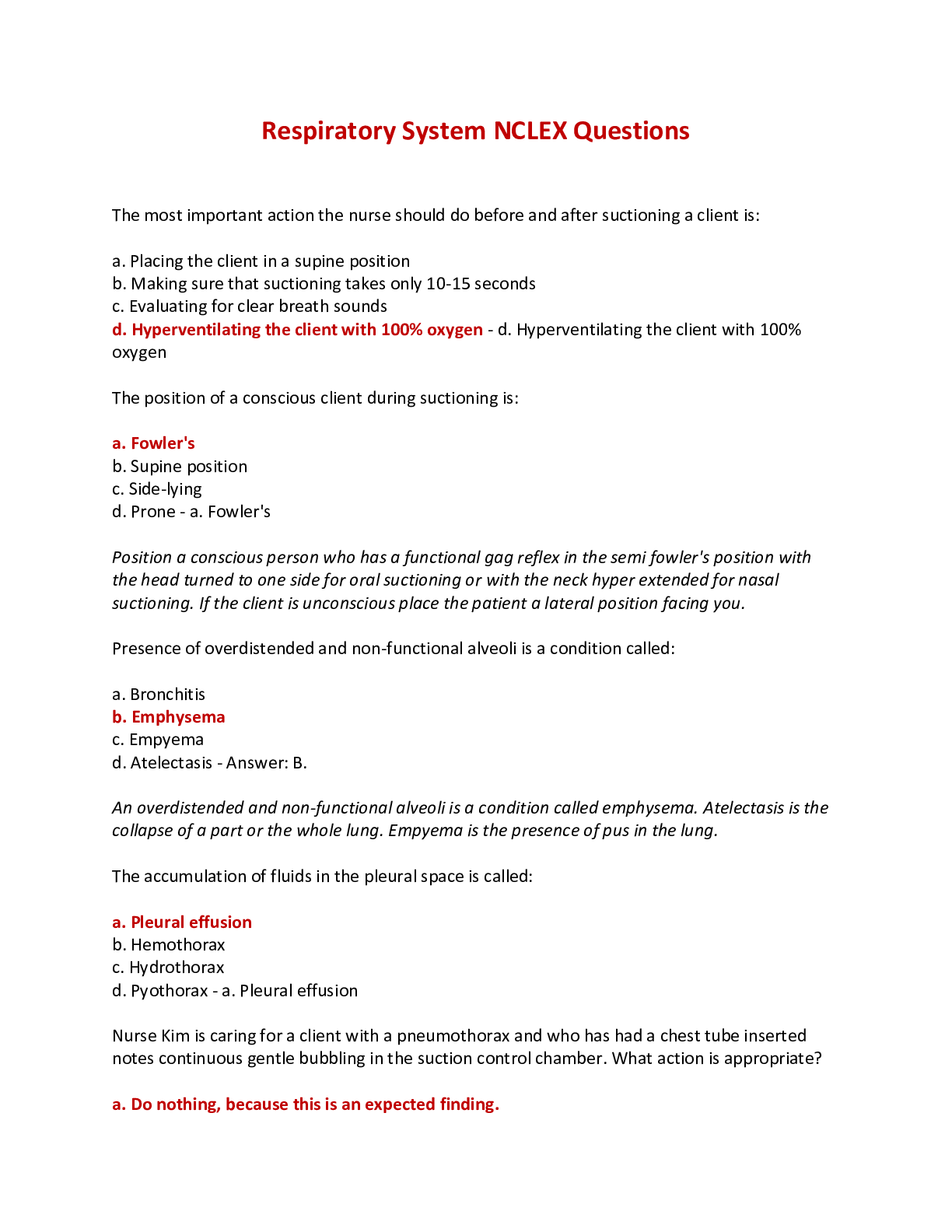
Reviews( 0 )
Document information
Connected school, study & course
About the document
Uploaded On
Jul 23, 2022
Number of pages
13
Written in
Additional information
This document has been written for:
Uploaded
Jul 23, 2022
Downloads
0
Views
37

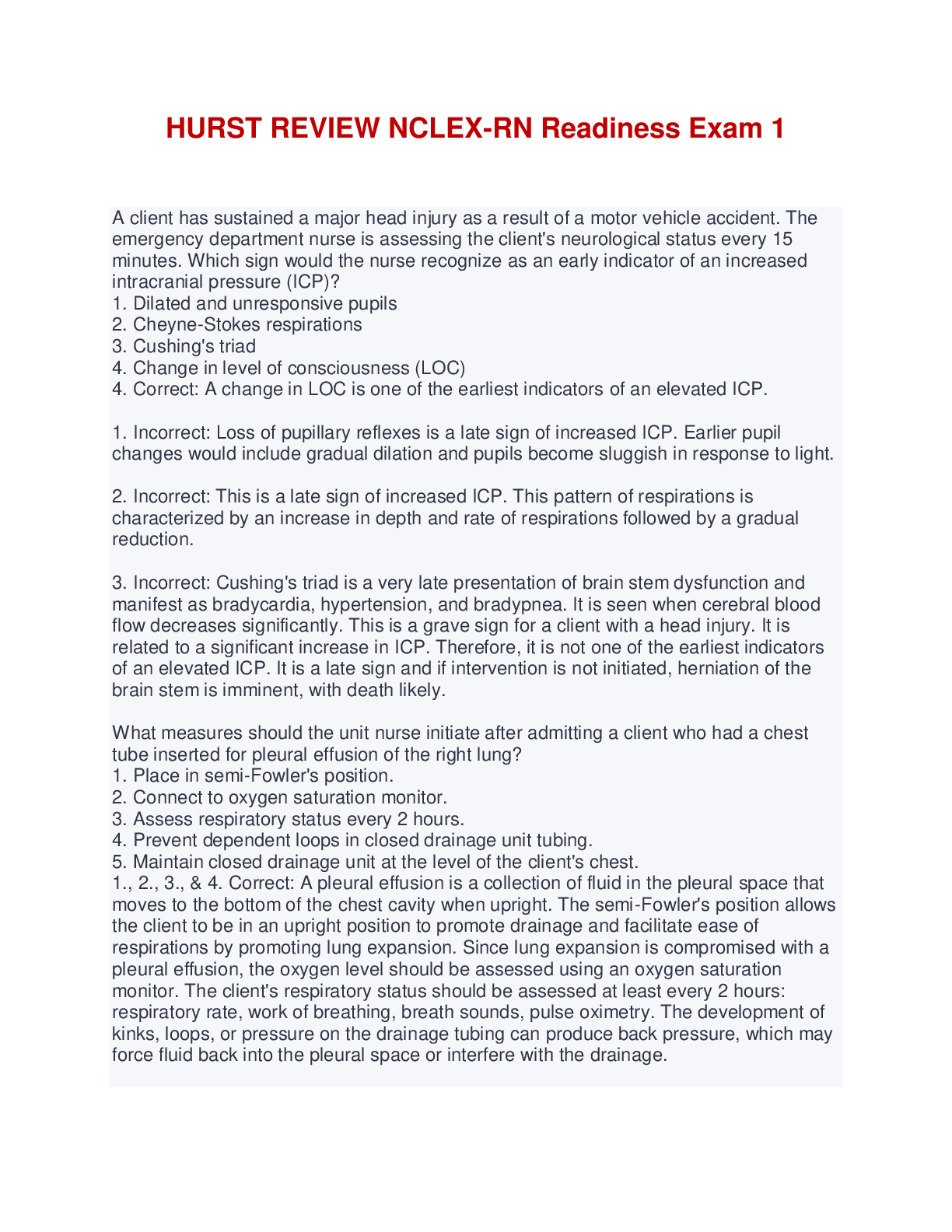
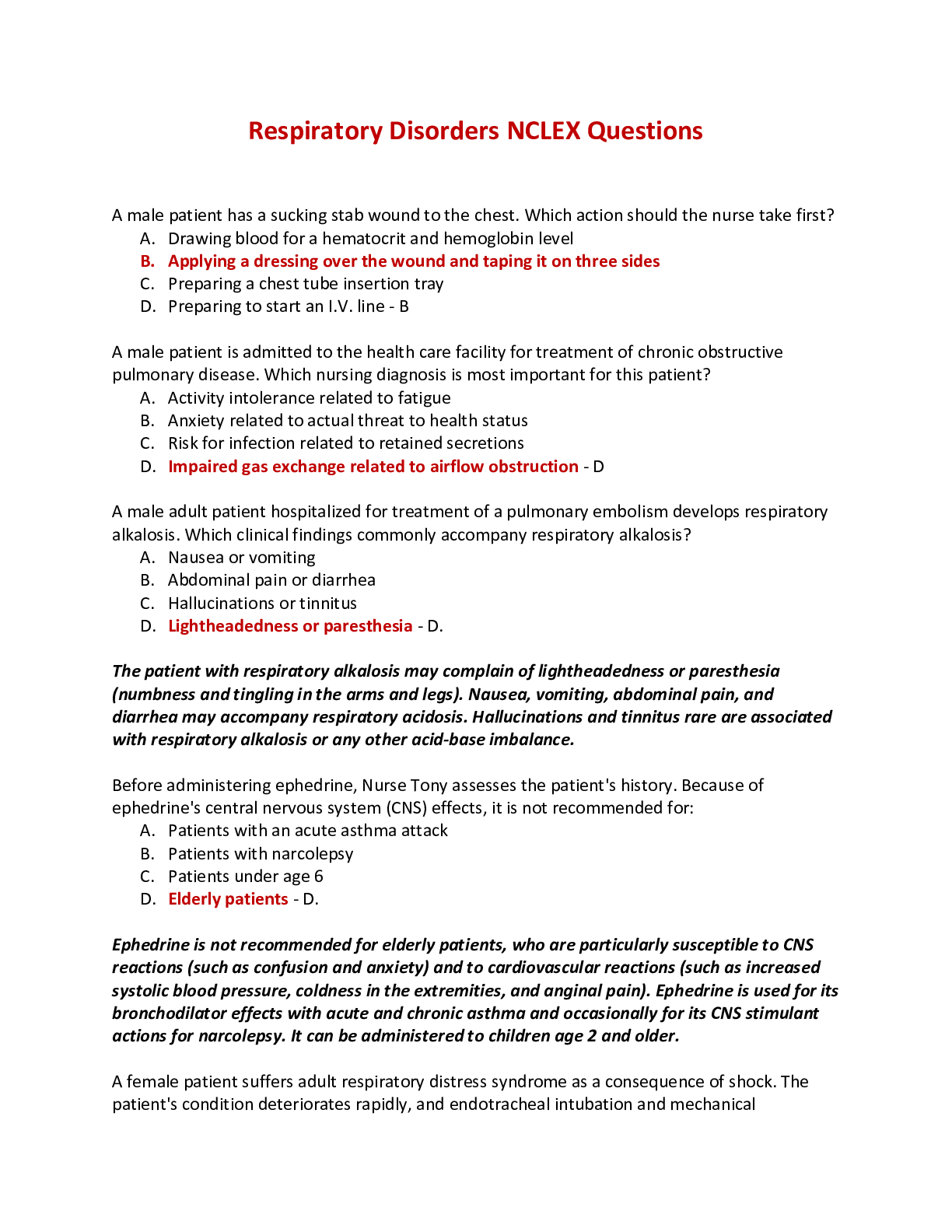
 NCLEX Study Guide.png)
